














































An insight into the news and trends shaping the region with perceptive commentary and analysis






Focusing on business growth, governance and employee wellbeing, ORO24 Developments’ founder and chairman Atif Rahman aims to create a value system, beyond the traditional corporate structure


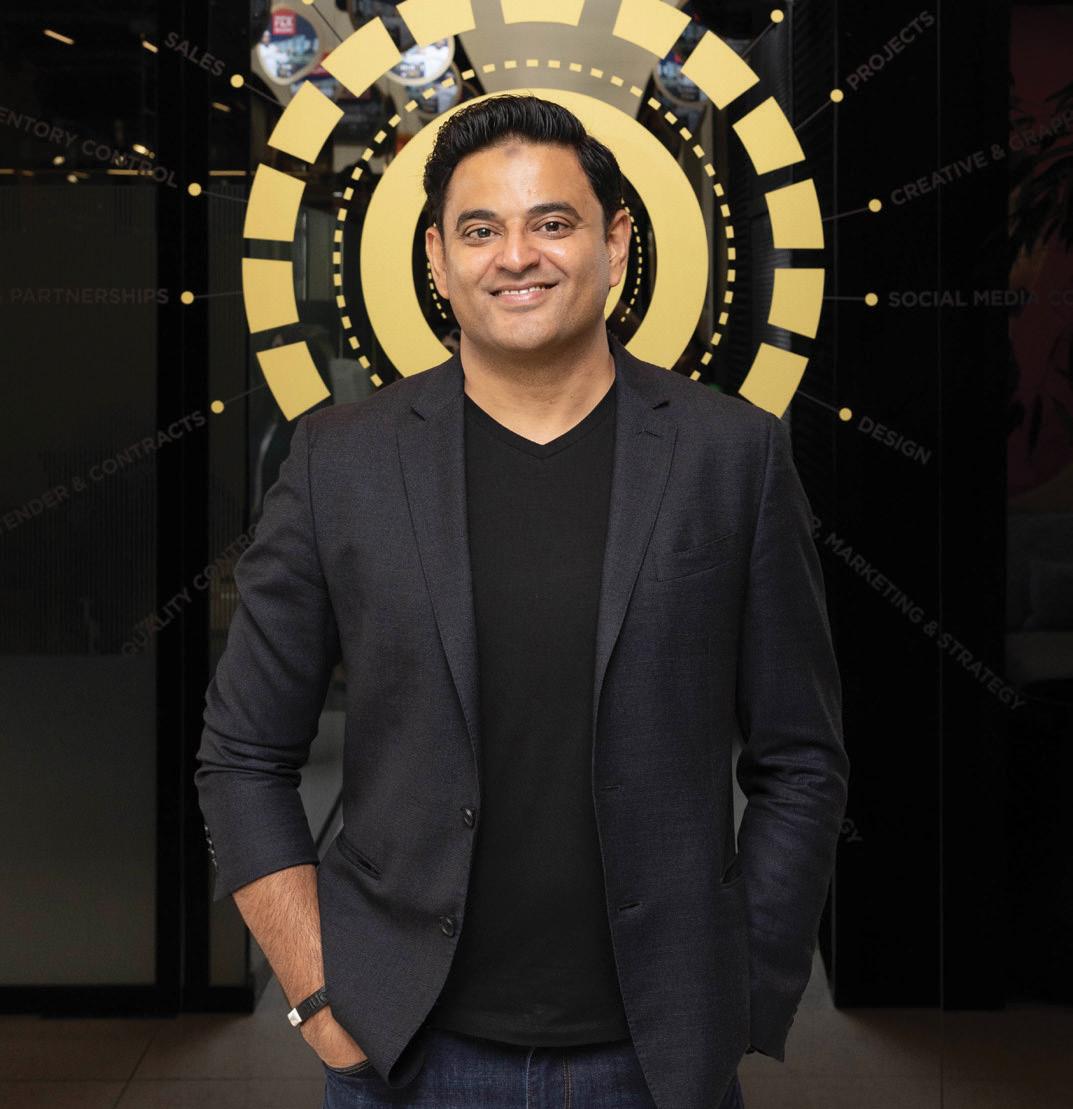


 Erling Haaland Pro footballer, member of the all-star squad
Erling Haaland Pro footballer, member of the all-star squad
What makes them tick? CEO of Parmigiani Fleurier, Guido Terreni reveals all p.60
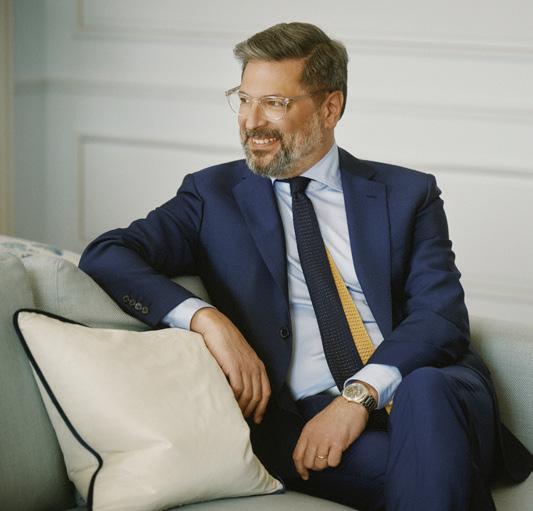
Big on beauty: We speak to the managing director of L’Oréal Middle East p.63

The Purosangue has arrived: Ferrari’s first ever four-door, four-seater is a stunner p.67

“We thank the team at the Mohammed Bin Rashid Space Centre for their efforts in developing the Rashid Rover, the UAE’s first mission to the Moon. The rover has officially cleared all required tests, bringing the first Arab mission to the lunar surface one step closer. Our next stop: the Moon”
Sheikh Hamdan bin Mohammed bin Rashid Al Maktoum, Crown Prince of Dubai and Chairman of the Dubai Executive Council
Interviews with entrepreneurs and insights from experts on how the regional SME ecosystem is evolving
manager – production S Sunil Kumar
manager Binu Purandaran
supervisor Venita Pinto
commercial officer Anthony Milne anthony@motivate.ae
Manish Chopra manish.chopra@motivate.ae
Gurjeet Kaur Gurjeet.Kaur@motivate.ae
Sonam Sharma sonam.sharma@motivate.ae
marketing manager Joelle AlBeaino

Fax: +971
677 0124, motivate-adh@motivate.ae


 THESE PLANS MAY BE SUBJECT TO THE OUTCOME OF LEGALLY MANDATED CONSULTATION IN SOME PARTS OF THE WORLD.
THESE PLANS MAY BE SUBJECT TO THE OUTCOME OF LEGALLY MANDATED CONSULTATION IN SOME PARTS OF THE WORLD.
Travel and tourism GDP declined by 50.4% ($4,855 bn) in 2020 vs. the overall economy’s decline of 3.3%
Travel and tourism GDP grew by 21.7% ($1,038 bn) in 2021 vs. the overall economy’s growth of 5.8%
Travel & Tourism Economic Impact 2022

a result of relaxed Covid-19 restrictions,
has made a roaring comeback
move past this point where Covid is overpowering our daily lives with everything we’re doing,” says Katrine Wallace, an epidemiologist at the University of Illinois, Chicago. In October, Japan recently began accepting vaccinated visitors from 68 countries without visas, ending almost three years of strict travel curbs that kept tourists out of the island nation; unvaccinated visitors will still need to test negative and possibly quarantine upon arrival.
Bhutan, a top destination for its awe-inspiring mountain views, spicy cuisine, and gilded temples, entirely scrapped its pandemic-related entry require ments for international tourists as of September 23, adding to the 30 destinations that ended testing and isolation mandates over the last several weeks. The Himalayan kingdom joins Canada, the Bahamas, and New Zealand, which also rolled back requirements for travellers recently.
Aside from mainland China, which remains off-lim its for tourists, the US, the Philippines and Indonesia are now the world’s only major tourist markets whose borders are fully shut to unvaccinated visitors, barring age or health-related exceptions.
Experts attribute the changes in policy to a relative stabilisation in death rates, despite a surge in infections due to the Omicron subvariant known as BA.5. That’s a result of mass-scale vaccination and booster campaigns, they say.
“We’re in a very different place today than we were two years ago, or even one year ago,” says Dr Wafaa El-Sadr, professor of epidemiology and medicine at Columbia University’s Mailman School of Public Health. “We have a deeper understanding about this virus, how we can manage it better, and we have sev eral vaccines that are increasingly available, which help alleviate concerns about Covid.”
vaccines and boosters are losing their importance for world travellers. There are now more countries and ter ritories‚ according to Kayak.com data‚ that welcome any US traveller without restrictions. Of the 109 destinations that still require testing, quarantines, or both for unvaccinated travel lers, 17 don’t allow US tourism anyway.
It’s a welcome turn for a global tourism economy that’s been hammered by the novel coronavirus, and a bright note for those looking for signs of the pandemic’s end. The pullback in restrictions is “an acknowledgment that we’re in a new phase of this pandemic, where things are more stable,” says infectious disease epidemiologist David Dowdy of the Johns Hopkins University School of Medicine. As recently as September 14, the head of the World Health Organization (WHO) declared that “the end is in sight” for the pandemic. “The world increasingly wants to
ALMOST TWO-THIRDS OF AMERICANS ARE PLANNING A TRIP DURING

NEXT
Having a vaccine is, of course, still the safest and smoothest way to see the world. It opens American passports to a potential 190 stamps without any testing complications. As a result of loosened restrictions, wanderlust has made a roaring comeback. Almost two-thirds of Americans are planning a trip during the next three months, despite sky-high prices and operational turbulence in an industry that continues to grapple with the lingering effects of Covid. For example, international air capacity is nearly 12 per cent below where it was at this time in 2019, according to Official Airline Guides, a global travel data provider, whereas domestic capacity has nearly caught up around the world.
“Countries which are heavily dependent on inbound tourists are seeing a slower rebound,” said Charuta Fadnis, vice president of research and product strategy at Phocuswright, a travel industry research company, in an email. “For example, many markets in Asia rely
heavily on Chinese travellers, and China’s restrictions on outbound travel impact the pace of their recovery.”
Phocuswright projects that China’s travel market won’t return to pre-pandemic levels until 2024. Still, Fadnis said Southeast Asia is “showing a good pace of recovery,” while Japan’s reopening would “provide a boost to the region.”



With much of Asia only starting to reopen, vacationstarved tourists have looked elsewhere. “This was really the summer of Europe,” says Josh Geller, a travel adviser at New York-based agency Embark Beyond. “We had endless clients in the South of France and Italy,” and those destinations “are still hot.” Even as temperatures cool, and travellers would normally seek warm-weather destinations, Geller says clients are still booking European vacations. He predicts that next fall and winter, Asia will overtake Europe as the top destination for jet-setters.
Client bookings have doubled compared to 2019 levels, says Geller. And now that Japan has reopened, he’s seeing pent-up demand to visit Asia in general. “Clients will call me saying, I heard Japan is opening up; what do you think about a trip to Vietnam?’” he
“IN OCTOBER, JAPAN BEGAN ACCEPTING VACCINATED VISITORS FROM 68 COUNTRIES WITHOUT VISAS, ENDING ALMOST THREE YEARS OF STRICT TRAVEL CURBS THAT KEPT TOURISTS OUT OF THE ISLAND NATION; UNVACCINATED VISITORS WILL STILL NEED TO TEST NEGATIVE AND POSSIBLY QUARANTINE UPON ARRIVAL”
says. Although removing vaccination requirements has taken some of the guesswork out of travel, Casey Hanisko, president of the Adventure Travel Trade Association, cautions that many operators and companies the trade group partners with are still requiring travellers to show proof of vaccination or negative test results to book places to stay or such activities as guided tours. And the onus, says Hanisko, is now on individuals to travel responsibly.
“E ectively, it’s don’t ask, don’t tell,’” says Geller, referring to the prospect of tourists travelling with Covid. Clients generally seem to be using judgment, he says, noting that those showing symptoms or testing positive for Covid are rescheduling trips.

With winter on the way, the seasonal character of most respiratory viruses makes it important to be a good human, regardless of o cial border policies. “This virus is still mutating. It’s still a threat,” says Wallace, the Chicago epidemiologist. As reported on October 3, the WHO attributes 9,126 deaths to Covid19 in the week prior. “It’s really hard to put the horse back in the barn.”
 Bloomberg
Bloomberg

PHOCUSWRIGHT PROJECTS THAT CHINA’S TRAVEL MARKET WON’T RETURN TO PRE-PANDEMIC LEVELS UNTIL 2024
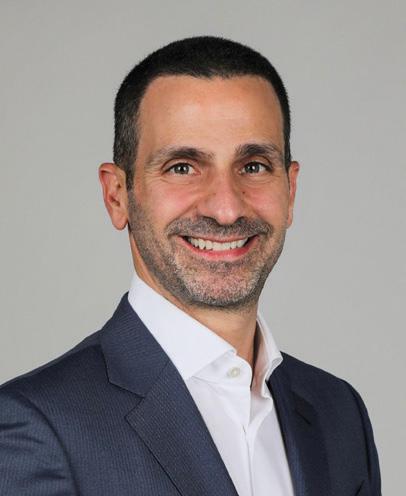
community wellbeing, as well as govern ance factors that cover the policies and processes which ensure an organisation’s accountability and transparency.
Disclosing sustainability performance does not automatically lead to positive outcomes. To achieve meaningful impact, companies must adopt a strategic approach to sustainability, by setting targets and goals to improve performance over time, and implementing the processes needed to deliver results.
Investors, customers, employees and suppliers are increasingly scrutinising companies for this behaviour and gravitat ing towards those that place environmental and social considerations at the forefront of their businesses.
The UAE’s commitment to net zero is a game changer, and companies that take early action to help meet this objective will see multiple benefits
TheUAE’s pledge to achieve netzero emissions by 2050 looks set to supercharge the transfor mation of the economy in the coming years. However, this game-chang ing commitment will only succeed if pri vate sector companies are prepared to step up and become key enablers of the country’s transition to a more sustainable future.
As the UAE prepares to host COP28 in November 2023, the government is already unveiling new strategies and initiatives to mobilise the private sector in support of the net-zero target.
In August, a cross section of 21 major local and international organisations signed up to the Ministry of Climate Change and Environment’s (MoCCAE) UAE ClimateResponsible Companies Pledge, vowing to work together to drive the decarbonisation of the economy.
Signatories have pledged to inten sify efforts to combat climate change by measuring and reporting their green house gas (GHG) emissions and develop ing science-based plans to reduce their carbon footprint, among other actions.
This just the latest sign that the UAE is very serious about its sustainability drive. While the country has for many years sought to embed sustainability in national strategies, this shift gained momentum in 2015 when the UAE signed the Paris Agree ment on Climate Change and the UN Sus tainable Development Goals (SDGs).
In line with this agenda, more and more UAE companies are choosing to dis close their performance on environmen tal, social, and governance (ESG) factors in the form of a sustainability report. In fact, since 2021 all companies listed on the Abu Dhabi Securities Exchange (ADX) and the Dubai Financial Market (DFM) have been required to publish these reports.
Material ESG topics typically cover environmental factors, such as GHG emissions, water consumption and waste management, in addition to social factors pertaining to employee, customer, and

By developing a sustainability strategy, companies will be better positioned to eval uate and manage ESG-related risks, attract new investors, customers, and talent, lower their cost of capital and enhance oper ational performance, among other benefits.
On the other hand, com panies that are slow to adapt risk becoming out of step with the values of their stakehold ers and falling behind their competitors as a result.
Given the growing empha sis on sustainability in the UAE, companies should also be prepared for the possibility that the government could introduce new legislation, compel ling companies to take stronger action on certain issues, particularly those related to climate change.
It is imperative that business leaders anticipate these transitional risks and act now to navigate a fast-changing world and build more resilient, future-ready businesses.
Ultimately, for companies to mitigate risks and maximise impact, they must move beyond making vague statements in support of sustainability and be able to demonstrate genuine progress. Their future prospects, and the ability of the UAE to achieve its goals, could depend on it.
inequality and made people reassess what it means to be wealthy. People are also becoming more aware of pressing environmental issues such as climate change.
With wealth in the spotlight, the reputational risks for the wealthy have increased if they are not seen to be acting ethically. We’re approaching a new era of transparency and accountability, with more indi viduals curious about how others spend their money. We’ve also seen a generational shift in the opinions around the purpose of wealth. Younger generations have grown up with a greater awareness of global social concerns and are questioning what their fami lies are doing with their wealth and whether they can utilise it to drive positive change.
These transitions present a great opportunity for families to examine the vision, values, and pur pose for their wealth and to integrate their approach across their businesses, financial portfolios, and phi lanthropy. Defining a core set of values, that everyone in the family agrees with, provides a way to engage younger family members by encouraging them to take on new roles and foster greater awareness. This can also aid in succession planning by preparing the next generation for the responsibilities that come with wealth.
Familybusinesses are considered an essential driving force of the Middle East’s economy. These businesses have played an integral role in transforming several industries in the region ranging from retail and property to energy and financial services. In fact, recognising their contribution to the economy, the UAE has recently launched a programme that aims to double familyowned businesses’ contribution to the nation’s gross domestic product to $320bn by 2032.
Wealthy families are increasingly exploring how they might contribute in a meaningful and lasting way to society, not just through philanthropy, but also in the way they run their businesses and manage their investment portfolios. The pandemic and global social equality movements have shed a light on
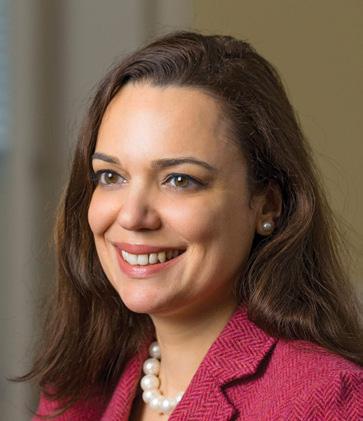
It used to be that families that made money through their operating business or investments would deploy those assets with one set of values and strate gies, and subsequently spend their private wealth on philanthropy and other family initiatives with a dif ferent set of values and strategies.
Family businesses can develop a model for sustain able family wealth by integrating their beliefs and purpose into all elements of their capital.

Many philanthropists are motivated by a strong desire to solve social problems and help others. Having spent years accumulating and growing their wealth, they want to give back and make the world a better place.
Many people’s charity aspirations will be guided by their values, ethics and what inspires them. They are often driven to give as a result of life events and choose to support issues that have personally affected them.
We are approaching a new era of transparency and accountability, with more individuals curious about how others spend their money
Involving the family in philanthropy can also leave a lasting impact. Engaging with the next generation in philanthropy can help teach them critical lessons about their family’s values and foster collaboration.
It may even assist in preparing children or grand children to run their own foundation. The Covid19 pandemic has uncovered complex societal challenges, ranging from climate change to inequal ity, underscoring the critical role of modern philan thropy in addressing them.
While conventional philanthropy has consisted of donating a percentage of one’s family, business, or individual fortune to charitable causes, wealth owners are increasingly finding opportunities to gen erate economic returns while also making a positive impact on the world. As a result of this approach, many families have aligned their charitable giving with their business and investing ambitions.
Business owners are increasingly realising that they must consider other stakeholders, in addition, to generating profits. They understand that their busi nesses could thrive when they take care of their employees as well as the communities in which they sell their products and services.
Many countries have made reporting obligations mandatory, outlining companies’ broader influence on society and the environment. For many busi nesses, this entails incorporating environmental, social, and governance (ESG) considerations into their existing procedures to address the societal implications of their commercial activities.
In recent years, several businesses have priori tised issues of social inclusion and racial equality. The growing prevalence of the climate crisis has also increased the emphasis on businesses reducing their carbon impact.
Impact investing is a growing trend that extends beyond ESG criteria to include investments that directly address social or environmental concerns in addition to financial gain. By incorporating impact considerations into investing in this manner, families may directly match their portfolios with their ethical and charitable ideals.
Overall, the most successful families that have owned assets for more than 100 years are those that adapt. It’s about being flexible and adapting to a changing world. Investment banking can help family businesses discover the approach that’s right for them and find the best ways to start implement ing their vision across all aspects of their wealth.

Theluxury retail sector is set to make a comeback after a lull during the pandemic, with reports indicating that the market is expected to grow annually by 5.40 per cent (CAGR 2022-2027). Interestingly, there has been a shift in luxury retail after the pandemic, with online sales of luxury goods on the rise.
Luxury retailers have historically been hesitant to move online but many transitioned to the e-commerce space during the pandemic. Two years on, many luxury retailers are happy to make their
As customers increasingly explore online mediums to shop for luxury fashion, brands are turning to digital platforms, including social media, to market goods
Maya Prabhu, managing director and head - Wealth Advisory for the UK, Europe, the Middle East and Africa, J.P. Morgan
Olivier Laurent, country manager of DHL Global Forwarding Abu Dhabi
THE LUXURY RETAIL SECTOR IS EXPECTED TO GROW ANNUALLY BY 5.40%
online transition more permanent, following a surge in online customers, and buoyed by predictions that sales from this segment could steadily rise in the future.
According to research, Generation Z and Millennials will account for 45 per cent of the global personal luxury goods market by 2025. Consumers are increasingly expecting to interact with their favourite brands online, and it is predicted that 25 per cent of luxury purchases will be made through the web in the next three years.
Consumers are also more demanding than ever, whether online, in-store, or a mix of the two. In response, retailers are revamping their e orts to create a seamless omni-channel supply chain that integrates ordering, storing, delivery and returns, no matter where the product is purchased.
But that isn’t enough. Retailers must also rethink their supply chains with the goal to build a portfolio of options, risk tolerance and capabilities to support a cost-e ective, flexible supply chain that meets consumers’ ever-increasing demands.
As customers increasingly explore online mediums to shop for luxury fashion, businesses are turning to digital platforms, including social media to market luxury goods. A strong digital team that knows their products well is vital for successful e-commerce presence and resultant sales.
Equally, meeting logistics needs of customers e ciently in the high-end e-commerce space is critical, now more than ever. Providing a consistent luxury experience to discerning shoppers requires seamless logistics to deliver competitive advantage, global expansion of luxury retail, multi-channel delivery and a personalised consumer experience.
Many logistics providers o er distribution and e-fulfilment services to drive value and customer
satisfaction, however, given the nature of the luxury industry, there is a need for high-quality packing, shipping, as well as superior track and trace technology from order through to delivery.
As price and margin pressures in developed economies are pushing retailers to rationalise inventory levels, cut transportation costs, and source lowercost goods from around the world, there is a need for reliable and cost-e ective logistics with a wide geographical reach and evolved capabilities when it comes to deploying technologies such as GPS tracking and RFID, especially in the fashion retail space.
It takes a lot of people behind the scenes to orchestrate truly great customer experiences that generate memorable outcomes. This couldn’t be truer for the luxury retail industry, which relies on bespoke services. That means information is just as important – possibly more – than the flow of goods. Personalisation is becoming more important than ever. Even an iconic brand like Chanel, which does not sell online conventionally, has partnered with online luxury retail platform Farfetch for in-store tech innovation to enhance the customer experience.
We work with online luxury retail platforms like Farfetch to ensure that high value items can be fulfilled from a variety of locations. Its global presence provides companies with the opportunity to unleash innovation to the fullest and explore new and exciting markets around the world
When it comes to the supply chain, deep local knowledge and experience are critical. Together with substantial capabilities, resources and automation, it can drive better deliveries and customer satisfaction. The logistics industry is already moving from traditional warehousing to automated processes to boost throughput, cut costs, and meet growing customer demand.
Logistics robots are also diversifying and achieving proficiency that matches and exceeds human capabilities. This can be a huge boon for luxury fashion, as it looks to gain more traction in the future. A more robust supply chain and a customer-centric approach will ensure that online luxury retailers move beyond their gilded physical stores and reach their intended audience.
“IT TAKES A LOT OF PEOPLE BEHIND THE SCENES TO ORCHESTRATE TRULY GREAT CUSTOMER EXPERIENCES THAT GENERATE MEMORABLE OUTCOMES. THIS COULDN’T BE TRUER FOR THE LUXURY RETAIL INDUSTRY, WHICH RELIES ON BESPOKE SERVICES”
technology firms that provide a wide range of services. One of those entities is Kx, a division of FD Technologies, which provides real-time continuous intelligence through a technology platform. Kx works with key organisations in the Middle East, supporting the fintech and financial services ecosystem. Collaboration of this type ensures that Middle East entities and businesses have access to technology solutions, supporting the wider growth of the region.
What makes the region an attractive destination for tech investment?
Give us an overview of Invest Northern Ireland’s (Invest NI) operations in the Middle East?
Invest NI started its operations in Dubai over 25 years ago. Since then, we have used our hub in Dubai to reach markets across not only the Middle East, but also India and Africa. We’re proud to work closely with Middle Eastern companies to find how they can be best supported by Northern Ireland business. In recent years, NI has exported up to £43m worth of products and services to the UAE alone, with over 100 companies active in the Middle East.
Over recent years, technology companies from Northern Ireland have produced a range of global success stories across a diversity of industries, spanning enterprise software, sports tech, IT services and govtech, agritech, healthtech and life sciences, edtech, fintech, cybersecurity, data analytics and smart cities. Today, around 30,000 technologists are employed in the country’s tech sector and in other sectors, such as advanced manufacturing and financial and professional services, with technology attributing to 3.3 per cent of Northern Ireland’s Gross Value Added (GVA). Added to that, in the last four years alone, there has been a 64 per cent
increase in the value of digital exports from Northern Ireland to the Middle East.
Northern Ireland’s companies are already active in the region. Can you share more about the type of work they are doing?
There is a range of Northern Ireland companies working across the Middle East, supporting the region’s businesses.
SLA Digital, which bridges the gap between mobile operators, merchants and mobile identity providers globally, creates additional revenue streams for all parties and helps to support operators in the Middle East maximise their revenues.
SLA Digital supports entities including Etisalat and Ooredoo in their day-to-day operations.
Skurio is an innovative digital risk protection platform which automates monitoring of the surface, deep, and dark web for critical business data and potential cyberthreats. These are just two examples of how NI tech businesses are enabling digital infrastructure in the Middle East.
How do you see Northern Ireland’s tech expertise contributing to the Middle East’s technology industry over the next five years?
Northern Ireland is home to a plethora of
Northern Ireland has become a global cybersecurity hub, with specialist university research centres, innovative startups delivering global cybersecurity solutions, and a cluster of international cybersecurity investors. International cybersecurity companies, like Rapid 7, Anomali, Synopsys, Imperva, Proofpoint and Contrast Security have located here. In addition to these cybersecurity product development companies, Northern Ireland is also home to international financial services companies such as Allstate, Aflac, CME and Citi.
Global professional services firms such as PwC, Deloitte, Ernst & Young and BDO, and technology companies, like Microsoft, BT, IBM Security and Nvidia all have significant security operations in the region and have developed a range of cybersecurity solutions.

Northern Ireland has extensive tech sector expertise, which has been recognised internationally and will continue to consolidate its reputation as a strong and innovative contributor to the global economy.
 Northern Ireland is supporting businesses in the Middle East through a range of advanced technologies, says Conor Dunbar, digital ICT sector lead at Invest NI
Northern Ireland is supporting businesses in the Middle East through a range of advanced technologies, says Conor Dunbar, digital ICT sector lead at Invest NI
As an in-demand asset class, proptech is opening up global markets for home buyers, as they no longer need to be in the market to make a purchase
The evolution of proptech offerings: The sector is moving incredibly fast, to deliver a range of services to customers. In the early days of proptech, most businesses focused only on classifieds and then on ibuyers. However, today we have moved from that to find platforms for mortgages; power buyers and in some cases full-service offerings.
Customers desire a complete experience: In this age of convenience, customers who are serious about their purchase, want to move fast. Instead of wasting enormous amounts of time across every stage of their journey, they prefer having a single platform for everything. They want the full experience starting at the top of the funnel with search, to the bottom of the funnel where they close the transaction and receive financing.
Customers want technology to enhance their expe rience: Finding and closing a home can be a time consuming and tedious process. With technology advances, home buyers seek an easy experience from discovery till they get their key in hand. For proptech companies, this is important as they must ensure that their technology is enabling an excep tional journey.

Real estate purchases are no longer a local trans action: As an in-demand asset class, proptech is opening up global markets for home buyers. They no longer need to be in-market to make a purchase. In countries like the UAE, we are seeing growing demand from buyers in Russia and China, among other source markets.
The fully digital experience enables trust with buyers who are seeking to build a global property portfolio.
For those entering the proptech space, what are the main challenges?
As a sector that’s going through change, newcomers could face a few challenges including:
What are the key proptech trends you’ve seen this year?
Real estate continues to be the world’s largest asset class, and very often, the single largest investment individuals make. Despite global economic uncer tainty, the real estate sector grew by 59 per cent yearon-year in 2021. The maturing proptech sector is not only aiding this growth, but also bringing in a new generation of homeowners. Some of the key trends we see include:
Slow pace of the industry: The sector hasn’t seen much change in the way things are done over the past few decades. Because real estate is low frequency and high value, with a lot of complexities, the sector doesn’t move as fast as other consumerfacing tech sectors.
Lack of enabling technologies: With multiple legacy players and practices in the industry, there is no single solution that binds services together. This includes developers, real estate agents, banks and mortgage brokers. Without banking APIs, digital signatures, integrations with CRMs and more,
technology can become a barrier rather than an enabler of opportunities.
Insufficient focus on lead quality: In their rush to grow, startups will seek to have the most listings on their platform. Instead, there needs to be a focus on high quality leads. A person who wants to buy today is more valuable than those who are only browsing. This is where having complete control of the experience helps, with verified listings, competitive pricing, and a fast transaction process.
Regulatory and legal challenges: While proptech businesses aim to transform the real estate sector, very often existing rules limit their growth potential. For entrepreneurs starting out, they must have a good grasp on existing regulations across the value chain, and explore ways to remove roadblocks to growth. This includes guidelines on financial transactions, property registration rules, mortgage processing and more.
How can companies across finance and real estate sectors create synergies to offer greater value?
In most cases, buying a home is still an offline transaction, with each company along the journey having their own sets of processes and rules. All of this creates layers of complexities for home buyers. Companies, whether in finance or real estate, need to look at how they can come together to support property buyers.
We’ve partnered with leading businesses, whether they are mortgage brokers, real estate agents, agencies, property developers or banks. By equipping these partners with our technology, we were able to quickly qualify customers for mortgages. Our property marketplace focuses on quality, eliminating inefficiencies and putting customers in control of viewing schedules.
By enabling various synergies, we consistently want to ensure that the entire journey of finding and financing your home is as exciting as the moment when you finally hold the key to your home in
Jad Antoun, CEO and co-founder, Huspyyour hand. Technology will shape the future of home buying, and we want to deliver a world-class experience across every region that we operate in.
Huspy recently raised $37m in Series A funding. How does the company plan to change the homebuying experience for customers?
Our Series A round, one of the largest in the MENA region, is a stamp of confidence in our business model. As we build the company into a categorydefining business, we remain focused on our mission to digitally transform and reimagine the home ownership journey.
With a single platform to find and finance a home, purchasing through Huspy is easier and faster than ever before. We are now focused on growing our teams in the UAE and Spain.
Our technology is scalable, and together with our talented teams, we can really make a difference to the home buying experience.
Every one of our properties are verified, with visits scheduled only as per the customer’s availability. We also qualify applicants for mortgages with the best offers suitable to their profile. All of this significantly reduces the time required in the entire purchase journey.
In fact, we have a conversion rate of over 90 per cent and we close mortgages three times faster than our competitors. And our real estate business is already seeing 30 per cent month-on-month growth.
Across traditional business models, technology has enabled convenience for all stakeholders in the process – whether for business partners or customers. Property marketplaces in the region have previously focused on classifieds alone. Beyond that, the customer is on their own to go through the rest of the process to find mortgages, real estate agents, schedule viewings and more.
That is why we believe the future of home buying is about providing a complete experience by using technology to connect all stakeholders in the process. At Huspy, we are enabling discovery at the top of the funnel. At the bottom of the funnel, we are helping people close and finance their homes.
By having a single and trusted place for trans actions, home buyers are assured that one of their most important life purchases is also their most delightful. Around the world, most home buying journeys start offline but less than 1 per cent are completed through digital channels. The opportunity ahead is significant and we are only getting started.
“IN THIS AGE OF CONVENIENCE, CUSTOMERS WHO ARE SERIOUS ABOUT THEIR PURCHASE, WANT TO MOVE FAST. INSTEAD OF WASTING ENORMOUS AMOUNTS OF TIME ACROSS EVERY STAGE OF THEIR JOURNEY, THEY PREFER HAVING A SINGLE PLATFORM FOR EVERYTHING”
HUSPY SAYS IT HAS A CONVERSION RATE OF OVER 90%
ITS REAL ESTATE BUSINESS IS ALREADY SEEING 30% MONTHOVER-MONTH GROWTH
Gender biases continue to govern occupation choice: While occupations have become more bal anced in the last 30 years, women remain underrep resented in much higher-paying management and technical occupations, especially the jobs that are seeing heavy demand today.
From an early age, children learn to follow gender expectations in play and career ambitions, based on the idea that girls and boys have different capabilities. Even though women have closed the college education gap in most countries, graduates of technical fields are mostly men.
At work, women prioritise flexibility more than men: The deeply rooted expectation that men work, and women take care of home duties continue to restrict women (and men). Moving to a flexible role can be a catch-22. Flexible work arrangements, like part-time work, can keep women in the workforce, but at a steep wage and career advancement cost.

What’s more, many women who continue to work full-time may steer away from “high-intensity” jobs, as they perceive them to be more unpredictable. Women are also more likely to take extended leaves. More than 30 per cent of women who reduced hours or took an extended leave say it hurt their career, compared with fewer than 20 per cent of men.
As companies grapple with current talent shortages, women can be a key part of the solution. Despite different starting points and cultural contexts, every country has an opportunity to bring more women into the work force, in order to meet talent needs and advance women’s empowerment. Understanding the differ ences – and similarities – between women and men at work is critical for addressing gender parity and winning the war for talent.
In our research on inclusion, we found that men and women feel equally included – and excluded – at work. And yet, women and men continue to have different outcomes and experiences in the workplace.
Bias continues to perpetuate differential treatment for women: Many workplace behaviours and structures are rooted in conscious and unconscious bias, with systems that were designed with the majority (men) in mind. This leads to differential treatment for women. While women often receive mentorship, or are shown what to do, many lack sponsorship – they are not championed for their contributions, as male leaders at the top are more likely to sponsor men.
Systems for promotion can also result in biased outcomes when leaders assess subjective promotion criteria, such as “leadership potential,” in a way that favours men. Women are also asked to do (and accept) more administrative work and emotional labour that generally isn’t compensated.

Leading firms will proactively address the gender imbalances that hold women (and men) back, with senior leaders championing the efforts, through the following five imperatives.
How empowering women in the Middle East can solve the labour shortage challenge
01. Be wary of averages: Treating women, men, or any group as a single block obscures the varied needs of individual workers. Recognising that multiple factors make up someone’s lived experience can help firms move beyond averages.
To attract and retain the best workers, while also ensuring that the right people are in the right jobs, leading firms are adopting a more tailored approach. For some workers, that will mean ensuring that their work is aligned with their passion. For others, that may mean offering flexibility paired with career progression.
02. Actively fight traditional gender bias with diverse role modelling and sponsorship: Gender bias can hold workers back from their full potential. Firms can actively challenge bias by elevating diverse role models, ensuring equal access to sponsorship, promoting allyship, and embedding concrete bias mitigation e orts.
Diverse role models play an important role in career aspiration. And seeing leaders who challenge traditional gender norms, such as men who have taken extended leaves for family care, can help mitigate bias. Seeing leaders with similar backgrounds can also improve aspiration and retention, but sponsors need not come from the same background.

Bias mitigation e orts in recruiting and promotion are also crucial. These can include redacting information from résumés during the review process and requiring bias trainings for interviewers, managers, and promotion reviewers.
03. Instill inclusive practices as an antidote to gender imbalance: We define inclusion as the feeling of belonging in one’s organisation and team, being treated with dignity as an individual, and being encouraged to fully participate and bring one’s authentic self to work every day. Bain research
Bianca Bax, EMEA head of diversity, equity and inclusion practice, Bain & Company, and Sara Minelli, associate partner, Bain & Company Middle East
shows that fewer than 30 per cent of women and men feel fully included at work, so there is plenty of opportunity for improvement.
Inclusion is necessary to maximise retention, performance, and innovation. We believe that there are three highly critical steps to boost inclusion for all: promote growth through professional development, coaching, and partnership; facilitate connection with affinity groups and networks of allies; and signal commitment with diversity, equity, and inclusion ambitions.
04. Champion flexible workers and eliminate barriers to their success: For workers who need or want flexibility, part-time or remote work can keep them in the workforce. But these arrangements o ten come with career deceleration and steep pay penalties. While more women are in part-time and flexible work arrangements today, men are increasingly prioritising flexibility, too.
Part-time and remote workers o ten experience bias, including in promotion. Remote workers are less likely to be promoted despite similar or greater productivity. Many of the same bias mitigation tactics for gender bias will also help workers who prioritise flexibility. Beyond bias trainings and eliminating ambiguous success criteria, leading companies will create opportunities for remote or flexible workers to have dedicated in-person time with their managers and firm leaders.
05. Unlock new talent pools through reskilling and returners programmes: Women are more likely than men to o -ramp and take an extended leave mid-career, o ten due to family obligations. And while roughly 90 per cent of women want to return, only 40 per cent actually do. Nearly three-quarters of women trying to return to work a ter voluntary leave have trouble finding a job.
Workers who have taken extended leaves represent a promising talent pool but may need to learn new hard or so t skills to re-enter the workforce. Returners programmes that o er training for indemand digital skills can also improve the gender balance in higher-growth occupations. In addition, reskilling or upskilling current workers can improve retention and develop a pipeline of diverse talent into management positions.
Addressing gender bias is a multiyear journey without a finite destination. But it is critical for ensuring that women at work reach their full potential. In the race for talent, companies cannot a ord to leave half their potential talent behind.

“DIVERSE ROLE MODELS PLAY AN IMPORTANT ROLE IN CAREER ASPIRATION. AND SEEING LEADERS WHO CHALLENGE TRADITIONAL GENDER NORMS, SUCH AS MEN WHO HAVE TAKEN EXTENDED LEAVES FOR FAMILY CARE, CAN HELP MITIGATE BIAS”
FEWER THAN 30 PER CENT OF WOMEN AND MEN FEEL FULLY INCLUDED AT WORK, SO THERE IS PLENTY OF OPPORTUNITY FOR IMPROVEMENT
NEARLY THREE-QUARTERS OF WOMEN TRYING TO RETURN TO WORK AFTER VOLUNTARY LEAVE HAVE TROUBLE FINDING A JOBSara Minelli

Why don’t we have more female entrepreneurs? You might think that you read about lots of women leading their own business, but the reason you do is because they are newsworthy, not because they are numerous. Between 2014 and 2020, data from MAGNiTT on startups in the MENA region shows that approximately only 2 per cent of startups were founded by women, another 2 per cent were co-founded by men and women and the remaining 96 per cent were founded by men. Look outside the region and you realise that the barriers to female participation in the startup ecosystem are pervasive. Many women, especially in developing economies, do not even have a bank account (over one billion females worldwide do not own a bank account) and might not even have the right to own land (40 per cent of countries have restrictions in place when it comes to female ownership of property).
But even in more developed parts of the world, getting a startup funded is easier, it seems, if you are male. Why is that? I suggest that one reason is that funders suffer from unconscious bias and gender assumptions. Traditionally, men are portrayed as being more successful and more ambitious than women. They
dominate the list of famous entrepreneurs and tend to define success in monetary terms. So, it has almost become a selffulling prophecy that men attract more funding than women.
It doesn’t help that most funders are themselves men. Female decision-makers form less than 10 per cent of the venture capital industry. Most bank credit committees, who make the decisions on lending money, are also full of men. People tend to like/trust/want to do business with people who look like them – there’s an academic word for this, homophily. What we need is more women in these key financing roles, so that more women entrepreneurs can get funded.
The lack of female startups being funded makes no sense to me at all. After all, there is a growing body of research that suggests women make better entrepreneurs than men. Surely, women are less likely to lose the money that has been invested in them? Women take more risk-adjusted decisions than men - put into stressful situations, the science shows that women take less risk than men.
Studies have also shown that women often make better leaders than men. When women become leaders, they provide a different set of skills and imaginative
perspectives. They are more empathetic, communicate better and handle crises better. They are more aware and emotionally intelligent about the human side of the business. These are qualities that give them a huge advantage as entrepreneurs.
Finally, women are good at multitasking, and successful in building connections and social networks, critical skills needed in any startup.

Yet, even with all these advantages, the reality is that female entrepreneurs are still facing barriers to funding. Many say that they struggle to be taken seriously, especially by maledominated venture capitalists and banks. What can we do to change this?
I am proud to live in a part of the world where female entrepreneurs are celebrated and supported, and where starting a business has never been easier. The UAE has embarked on several new initiatives that foster entrepreneurship and encourage business formation, including letting foreign entrepreneurs be 100 per cent shareholders in a locally incorporated business, making long-term residency visas available, and facilitating business formation. The Dubai DED Instant License permits entrepreneurs to get a licence in five minutes with no pre-approvals. Hardly surprising then, that the UAE has been ranked first in the in Middle East and fourth globally in the Global Entrepreneurship Index (GEI) 2020.
Women have always been important agents of change and harnessing the potential of women entrepreneurs is crucial for economies that are sustainable and inclusive. If you are female, have a potential business idea and have been sitting on the fence about starting your own venture, then why don’t you use Women’s Entrepreneurship Day as encouragement to get out there and just do it? And finally, let’s not forget that we also need more women to help other women make their business idea a success. So, if you are a woman reading this - maybe this is the time for that new career in venture capital?
Harnessing the potential of women entrepreneurs is crucial for economies that are sustainable and inclusive, says Professor Heather McGregor CBE, provost and vice principal of Heriot-Watt University Dubai


Israel exported $188m in rough diamonds to the UAE in 2021, and that number is set to grow after the nations signed a free trade deal in June
into a new era of partnership. But it also reflected another, less publicised fact: That long before o cial ties between Israel and the UAE were established, business figures from both nations were linked by the trade in precious stones. One might even say that the road to the open economic cooperation between Israel and the Emirates created by the Abraham Accords, was paved by diamonds.
For Israel, the diamond industry is a long-established key sector of its economy whose beginnings pre-date the establishment of the state. The trade in precious stones had for centuries attracted the Jewish merchants of a diaspora scattered across the globe and in need of a universally-accepted, easily-transported currency. In the 1930s, Jewish dealers from Germany immigrated to then pre-state Israel, bringing their expertise in polishing and trading precious stones. The IDE was established in the Tel Aviv suburb of Ramat Gan in the 1960s and now boasts some 3,100 members, while cut and polished diamonds account for some 23 per cent of Israeli exports.
The UAE is a newer power in the world diamond market, but has made remarkable advances over the last two decades. Dubai’s position as a pre-eminent regional trading hub and magnet for luxury global tourism, and its proximity to Asian centres of precious gem production, have made it a natural centre for the industry. The DDE, which was established in 2002 under the umbrella of the Dubai Multi Commodities Centre (DMCC), has over 1,100 licensed companies. It now handles some $25bn in total trade, double that of Israel’s IDE.
Post the Abraham Accords, the links between the Israel and UAE diamond industries have quickly advanced. The DMCC opened a representative o ce inside Ramat Gan’s IDE in late 2020 – and the IDE did the same in Dubai’s DMCC this past February.






OnSeptember 17, 2020, just two days a ter the signing of the Abraham Accords in Washington and the establishment of diplomatic relations between Israel and the UAE, the Israel Diamond Exchange (IDE) and Dubai Diamond Exchange (DDE) signed a cooperation agreement. The document committed the IDE and DDE to establish o ces in the other’s headquarters and promote bilateral trade and joint projects.
The speed with which the agreement was reached certainly indicated the enthusiasm with which the world’s two leading diamond exchanges entered











Israel exported $188m in rough diamonds to the UAE in 2021, and that number is certain to grow a ter both nations signed a free trade deal in June, eliminating customs duties on 95 per cent of products, including cutting the tari s on diamonds and precious gems from five percent to zero.
And it may be that the role the diamond trade played in pre-figuring the ties between Israel and the UAE, might be replicated elsewhere. Although Israel and Qatar still don’t have o cial diplomatic relations, the two have reportedly reached an agreement on allowing Israeli diamond traders to do business in a new free trade zone for precious stones and gold in Doha, set up along the model of Dubai’s DMCC. So the glittering path paved by diamonds to the Abraham Accords, might yet end up extending even further in the Gulf.

THE DDE, HAS OVER 1,100 COMPANIES LICENSED AND NOW HANDLES SOME $25BN IN TOTAL TRADE
This involves understanding the diverse and specific needs of private sector entities and tailoring our solutions to best meet their requirements.
A big part of this is strategic investments that are directly linked to sustainable solutions. FAB has been an industry leader in green financing since we issued the region’s first green bond in 2017. But our engagement extends well beyond the ‘financing’, as it includes advisory and education in the communities we serve, as well as in measuring market emissions.
On October 6, 2022, First Abu Dhabi Bank (FAB) brought together some of the world’s brightest minds in climate action when it hosted the Economist Impact’s Countdown to COP27 Summit. Among these were philanthropist Bill Gates and US Special Presidential Envoy for Climate –John Kerry. They were joined by leading UAE business and environmental figures such as Sheikha Shamma bint Sultan, founder and CEO of Alliances for Global Sustainability; Hana Al Rostamani, Group CEO of FAB; and Mohamed Al Ramahi, CEO of Masdar.
In one of the standout moments from the summit, John Kerry outlined his vision as well as his pragmatism for net zero by telling the audience that: “This is a moment that is unbelievably exciting… this is also an opportunity for big economic transition that will be as big as the Industrial Revolution”.
But Kerry’s vision struck a more realistic tone when he indicated that “the transition to net-zero and the estimated $4tn needed can be achieved ‘only’ with the support of the private sector”, he went on to say that: “There’s barely a government in the world that has money to do this. I believe this very deeply. We don’t get there without the private sector”.
In my view, the banking industry will spearhead that private sector participation that John Kerry spoke of. This is because banks have a unique window into the entire economy, they uniquely touch every
sector, and interact with almost every individual.
To date, banks are already facilitating private sector engagement in net zero, and this will surely deepen and widen in the coming years as the world’s financial institutions play a more profound role in helping corporations walk the talk on their climate ambitions.

To put it more specifically, banks provide strategic advisory and innovative sustainable financing, so they are well positioned to lead the change across the private sector by financing the future direction of energy supply, buildings, transportation, waste, water, and food.
I also believe that COP27 this year will further underscore the power of finance on the road to net zero.
At FAB, as the UAE’s leading bank, we are stepping up and playing a decisive role in efforts to drive climate action through our proactive engagement and partnerships with our customers, clients, and the UAE government and regulators. We’re operating across the full breadth of the private sector by working collaboratively with large corporates and SMEs. We’re helping them to unlock new possibilities and enabling them to redefine the rules of their engagement with net zero and the possibilities that it brings.
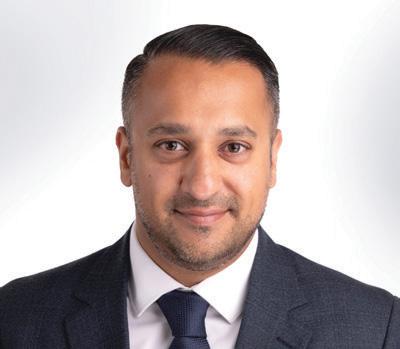
At FAB, we’re combining near-term action with a long-term view. In recent memory, we’ve made tangible progress and now we’ve set clear targets in relation to climate action. Around one year ago, we were the first UAE and regional bank to join the Net-Zero Banking Alliance (NZBA) – in doing so we committed to achieving net zero by 2050. Alongside this, we have set a target of $75bn in green financing for the period 2022-2030.
In addition, we believe that information and disclosure will be crucial to drive the climate action needed to turn ambition into action. Putting these standards in place will prove critical in helping investors assess climate and sustainability risks and opportunities, which in turn will direct capital toward long-term sustainable projects. To achieve the required systemic change across global economies, we will need the best efforts of individual institutions: we will need coordinated action across the entire public and private sectors so that every financial decision takes climate into account especially now that more than 80 per cent of global GDP is covered by a net-zero pledge according to the University of Oxford.
All eyes are now firmly fixed on MENA as it hosts the next two COPs: COP27 in Sharm El-Sheikh, Egypt and COP28 in the UAE. Perhaps now will be the time to turn principles into lasting progress.
At FAB, we’re ready to play our part in turning the environmental crisis into an immense opportunity that will benefit both people and planet alike.
Banks are already facilitating private sector engagement in net zero, and this will deepen in the coming yearsShargiil Bashir, chief sustainability officer at First Abu Dhabi Bank



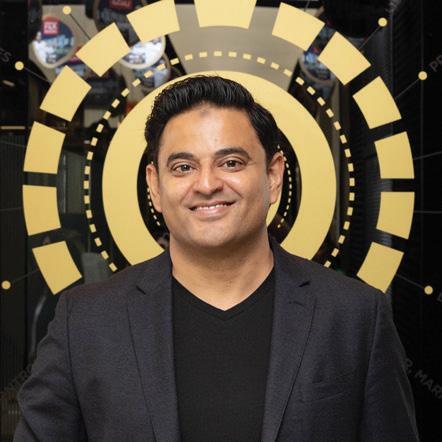

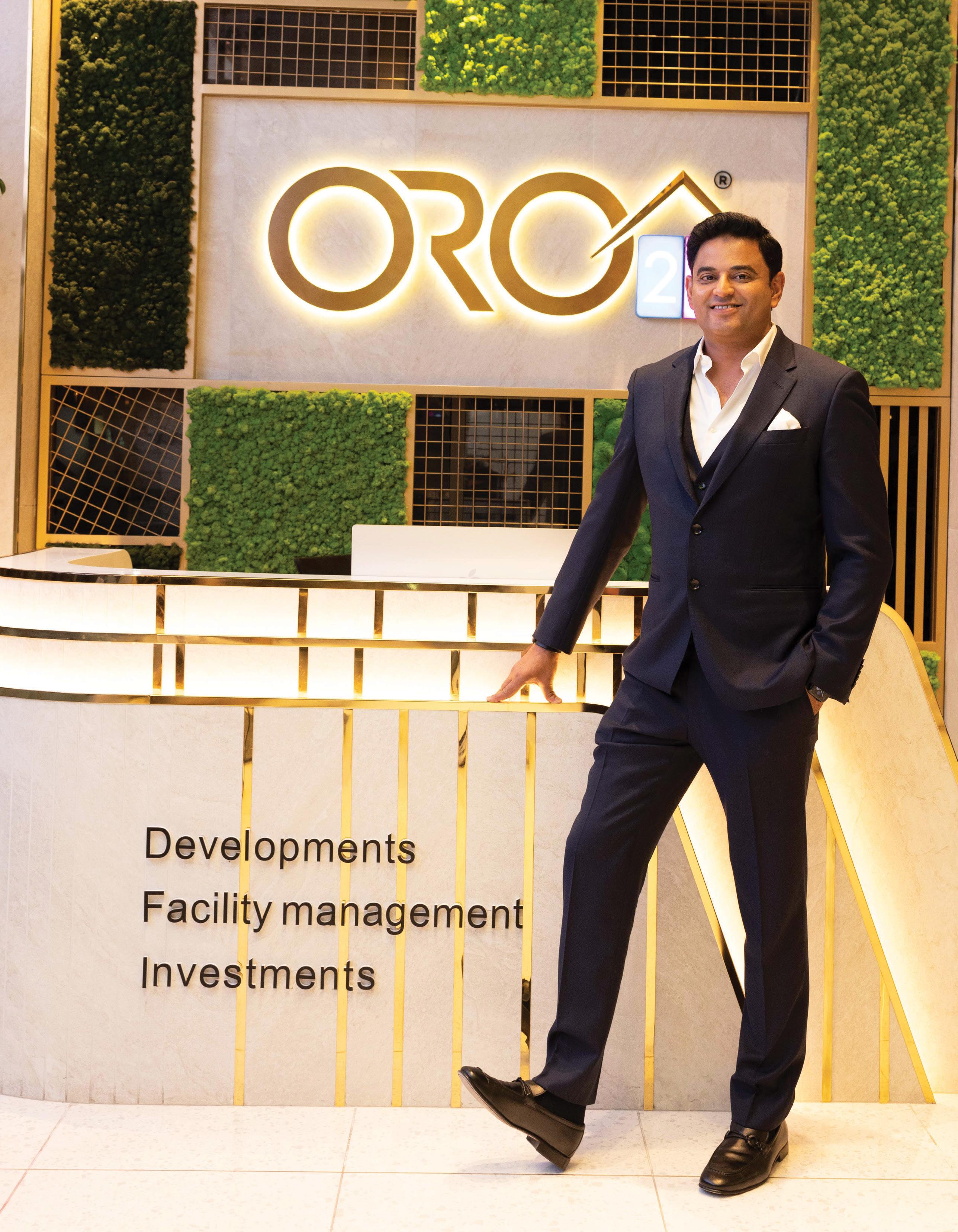


Aserial entrepreneur nurturing tall ambitions and a relentless drive to achieve them, Atif Rahman comes across as a strikingly humble, yet undoubtedly determined business leader. At the helm of his new real estate venture, ORO24 Developments, which recently completed a year of operations, Rahman believes that success is an inclusive phenomenon, achieved alongside people who share the same vision and determination.

“Success is not a siloed concept – we aim to become a people-centric brand delivering value to everyone who associates with us,” he explains. Rahman personifies that narrative in every sense, from his personal life to his company’s operations. From his choice of location for the company’s centrally-located headquarters to help ease employee commute, to his decision of curating an office space that echoes his mantra of holistic wellbeing, the chairman is resolute in his commitment to develop a people-sensitive business.
“I feel every organisation plays a vital role in their employees’ lives. It is where they spend a major part of their time, hence it is pivotal to create a space that gives them the requisite psychological comfort. It is also important to have inclusive people because they create internal and external partnerships for better business outcomes,” says Rahman, whose enthusiasm, drive and energy are not just palpable, but also inspiring and infectious.
From a small-town boy with towering aspirations to launching ORO24, Rahman has come a long way. The company’s inaugural project TORINO by ORO24, an exclusive gated residential community situated in Arjan has been very well received, with units being sold out within weeks. The land on which the project is being constructed was originally earmarked for only three individual buildings. However, Rahman explains, “I am an advocate of community development; and could only imagine a community in that area. That’s how we redesigned the land and created a six-building gated complex, with several amenities.” The project is scheduled to be completed by 2024.
Despite his recently launched property venture, Rahman is not new to the real estate and construction landscape, having invested over two decades in multiple roles across the space. In spite of spending his formative years creating play homes with makeshi t materials and clay bricks, his foray into the industry wasn’t a linear one. “Almost everyone in the family was involved in property development, but I chose to graduate in computer science, as a rebel to stay away from the industry.
I started my career in India in the field of IT, but fate had planned otherwise, as in just over a year, I was back in the construction sector,” he adds.

“I am a firm believer that one’s life is largely a reflection of their upbringing. I was fortunate enough to grow and understand the crux of construction under the guidance and wisdom of my grandfather. He and my father, who instilled values of simple living and high thinking, have helped shape me and my aspirations. I am excited to take on challenges, through the lessons they’ve imparted. I am also deeply inspired by the future-forward vision of the country’s dynamic leadership.”
Rahman arrived in Dubai 18 years ago at the behest of his family - a hesitant step at the time, but a move he now considers as “one of life’s best decisions”.
“Little did I know at the time that Dubai o ered a reservoir of opportunities. Real estate and construction are my passion and the emirate o ered an ideal ecosystem, as things happen at a rapid pace here. It is here that I have launched 27 mid-to-large real estate projects, spanning over 10,000 units. Yet, every day I realise that there is much more to learn,” he adds.
It is easy to understand why. Rahman’s past endeavours and future pursuits to deliver quality real estate solutions are against the backdrop of an evolving and supportive landscape. Owed to a number of factors, Dubai and the UAE have been a fertile spot for property development and investments. The emirate recorded a total of 22,504
SUCCESS IS NOT A SILOED CONCEPT – WE AIM TO BECOME A PEOPLE-CENTRIC BRAND DELIVERING VALUE TO EVERYONE WHO ASSOCIATES WITH US”
RAHMAN HAS LAUNCHED 27 MID-TO-LARGE REAL ESTATE PROJECTS, SPANNING OVER 10,000 UNITS
property sales transactions worth Dhs59.154bn in the second quarter of 2022, reporting its highest quarterly volume of sales transactions for the last decade, according to Mo’asher, Dubai’s sales price and rental performance index launched by Dubai Land Department.

“In my opinion, the UAE is amongst the top three countries in the world, having achieved massive growth in last two decades. In most of the countries, the private sector is ahead of the government sector, while here in UAE it is the opposite, with the latter’s vision, planning and execution always scaling new heights. In such a fertile environment, every business has to transform and deliver innovation,” notes Rahman.
In an attempt to ensure that Dubai and the wider country’s real estate spectrum remains competitive and a step ahead of the rest, key legislations have been introduced. A new decree incentivising property investment funds in Dubai was issued this year to enhance the emirate’s status as a real estate investment destination. Visa reforms announced by the UAE government are also set to catalyse growth and boost the competitiveness of the local economy. Rahman adds that such reforms and prudent initiatives have boosted consumer confidence, thus leading a transition towards property ownership. “Through its recent immigration laws, the UAE government has completely recalibrated the regional landscape. The expat population, which is a sizeable number, is now confident of considering the UAE as its home. The rise in property sales has been boosted by an influx of people keen to reside in the country, which is also a direct outcome of the crisis management demonstrated by the government during the Covid-19 pandemic.”
In January, the UAE also announced that it would introduce a federal corporate tax on
business profits effective for the financial years starting on or after June 1, 2023. The standard statutory rate has been set at 9 per cent for taxable income exceeding Dhs375,000. Rahman endorses the decision, given the country’s global standing. “Today, the UAE is a global economic powerhouse and it has to level the playing field for collective good. The proposal of corporate tax is another step towards that. The first immediate impact of the directive will be the transparency it would deliver across corporate financial statements. It will further enhance opportunities and only amplify the spend on infrastructure and public welfare,” he adds.
Despite Rahman’s pursuits, there have been several factors that have exerted a negative impact on businesses and industries worldwide – factors well beyond any company’s control, such as the Covid-19 pandemic and the more recent Ukraine crisis. A series of interest rate hikes to quell inflationary pressures could also tip the global economy into recession.
Rahman has a different take on it. “Every financial expert and businessperson understands that a recession is a natural economic phenomenon that occurs when its time in the economic cycle is due. Highly-leveraged businesses with poor planning and governance suffer during recessionary times, while others only experience a minor deviation in their projections. The slowdown caused due to the pandemic had already started correcting the economy, so in my opinion, the effect of the impending recession would be mild.
“As far as the local economy is concerned, we will experience extremely reduced impact in comparison to the rest of the world. Today, there is a belief system which is attracting global investment into the country. The UAE is a fully matured economy with better policies, trade liberalisation, immigration reforms and a crisis management ability, thus minimising the impact of any economic downturn.”
“WE ARE WORKING ON CREATING A FULLY INTEGRATED PROPERTY MANAGEMENT PLATFORM ENABLED THROUGH SMART SERVICES AND AIM TO LAUNCH IT BY THE FIRST QUARTER OF 2023”
Focusing on business growth, governance, risk mitigation and employee wellbeing, Rahman aims to create a value system, beyond the conventional corporate structure.

“From an operational perspective, the company has been planned across three divisions – a property development division, which will be forward integrated into the facilities management unit and further backed by the investments division. The property development arm has been designed across five verticals, which include affordable housing, premium luxury, co-habitation, business parks and hospitality,” explains Rahman.
At the end of its first year, the company sits at a project portfolio of Dhs800m ($217m) and is set to launch its next project, which Rahman says will “redefine community living”.
“From space planning to amenities, the new project will o er unparalleled features,” he adds.
But for the chairman, property development needs to be underpinned by techno-commercial-legal core competencies to mitigate risks. “O ten, a step taken forward is di cult to be undone. I strongly believe that we must chart our progress carefully. Our prime goal is to enhance our capability of delivering quality solutions with a ordability as an important factor.”
The company also remains cognisant of evolving customer preferences, unprecedented digitalisation and the prospect of emerging technologies shaping the future. “Technology and digitalisation form a critical part of our business infrastructure. We have incorporated artificial intelligence (AI) in all our business operations, which is an ever-improving process. We have acquired perpetual so tware licences, which help run the business e ciently and invested in some unique digital and hardware components for a better user interface,” Rahman adds.
Additionally, the management has prioritised corporate social responsibility (CSR), which Rahman feels must first reflect internally. “We have modelled our business from its inception to include governance, transparency and risk management at the forefront. The business is supported by firms offering fund and financial advisory, separately. There are also six governing bodies that operate the business, covering areas such as management, investment, risk, audit, digitalisation and business development, with two more in the works,” he adds.
With a roadmap in place, Rahman is ready to lead his venture across new verticals and geographies. But for the imminent future, he remains razor-focused on achieving micro yet key milestones. “We are working on creating a fully integrated property management platform enabled through smart services and aim to launch it by the first quarter of 2023,” he explains.
“Beyond that, we harbour long-term plans and intend to expand our horizon not just locally but globally and across verticals, with our belief firmly rooted in organic growth. Ultimately, our philosophy revolves around innovation, a ordability and unique product development.”
Strong on inclusive success, it isn’t a surprise when Rahman’s tips to other entrepreneurs are rooted in people and value creation. “We build spaces for people to live in or to operate businesses from. Customers plough in their hard-earned money, hence it is essential to protect their interests and their investments. But, for any organisation to be good to external stakeholders, it first needs to be sensitive to its own employees - this for me is the benchmark of a great workplace.”
TODAY, THE UAE IS A GLOBAL ECONOMIC POWERHOUSE AND IT HAS TO LEVEL THE PLAYING FIELD FOR THE COLLECTIVE GOOD. THE PROPOSAL OF CORPORATE TAX IS ANOTHER STEP TOWARDS THAT. THE FIRST IMMEDIATE IMPACT OF THE DIRECTIVE WILL BE THE TRANSPARENCY IT WOULD DELIVER ACROSS CORPORATE FINANCIAL STATEMENTS”
AT THE END OF FIRST YEAR, THE COMPANY SITS AT A PROJECT PORTFOLIO OF DHS800M

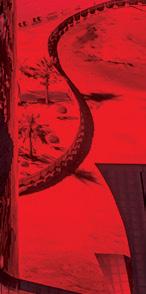








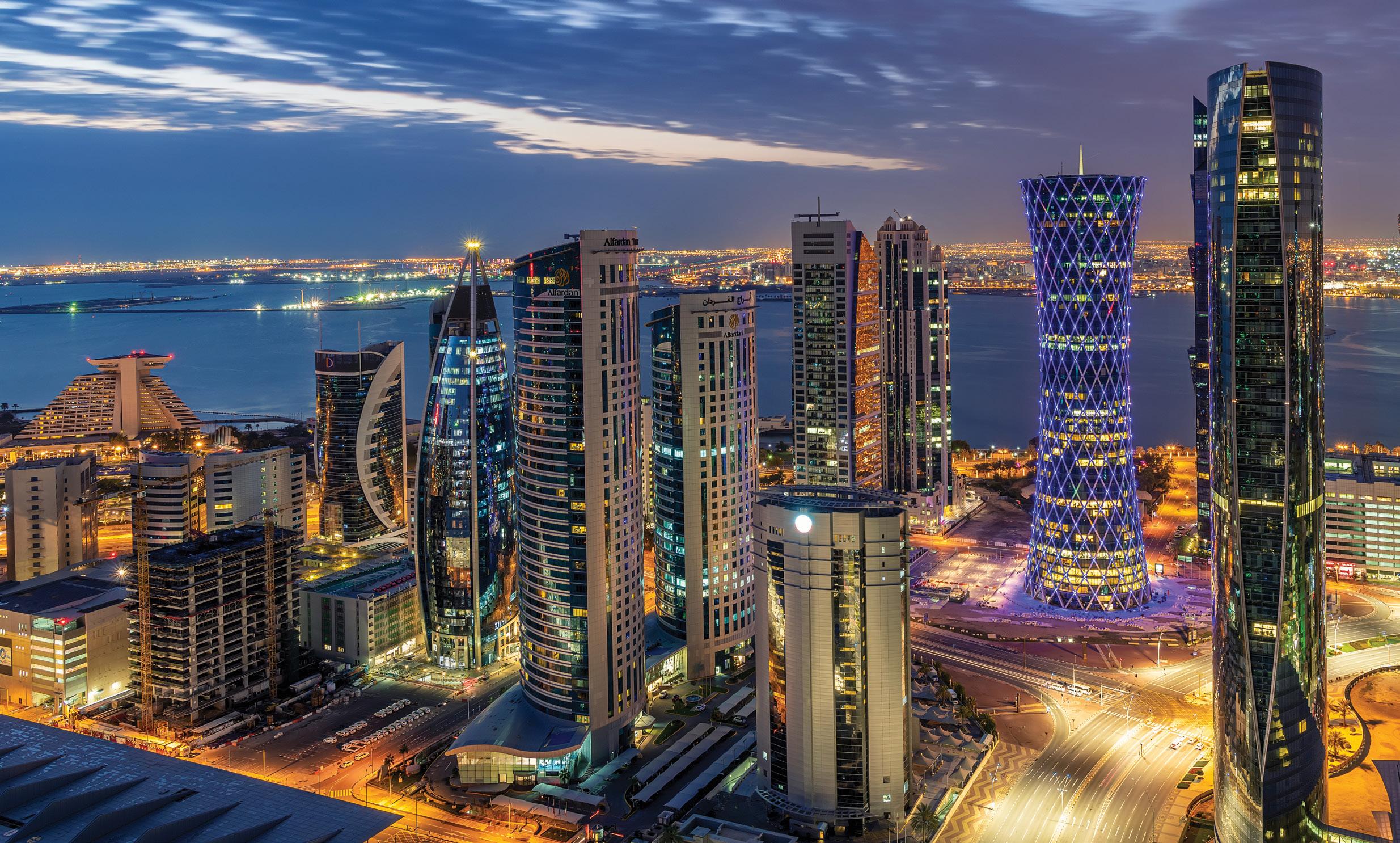

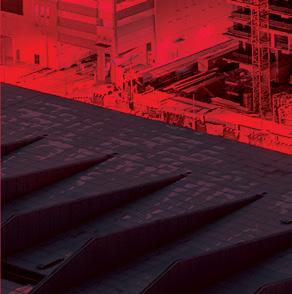
Teams? Ready Fans? Ready Qatar? Ready
In securing the rights to host the 22nd edition of the FIFA World Cup, Qatar became the first Arab nation to win the privilege back in 2010. It did so by beating bids from heavyweights such as the US, Japan, Australia and South Korea.

On winning the rights, Qatar swung into action. More than a decade later, the country is set to welcome football enthusiasts from around the world, as it gears up to host one of the greatest sporting events later this month.
This year’s tournament, which will run from November 20 until December 18, is one of several firsts. It is the first World Cup to be hosted in the Middle East and to be played outside the summer months of May, June or July. It is the first time in World Cup history that female match officials - three referees and three assistant referees – have been appointed. The tournament will also host the first fully-demountable venue in its history, and with all stadiums within a 50-kilometre radius of central Doha, this year’s event will have the most geographically compact footprint ever.
From an economic standpoint, the tournament has been a growth enabler and is expected to be a driver of sustained development and global interest going forward.

“The World Cup is not only an auspicious strategic instrument as a stand-alone occasion, but it is also a vehicle for achieving a thriving economic landscape beyond 2022, and an integral part of the bigger picture set forth by the ‘Qatar National Vision (QNV) 2030’,” a PwC report reads.
“From the time they won the World Cup bid in 2010, Qatar did see a gradual move towards diversifying its domestic economy, as evidenced by the reduction in its oil and gas contribution to GDP from 53 per cent in 2010 to 39 per cent in 2020,” explains Rituparna Majumder, industry principal, economic analytics practice, Frost & Sullivan. “Further, over the years, notable progress has been made in other sectors such as construction, wholesale and retail trade, finance, human health and social work. The share of the construction sector, increased from 6 per cent in 2010 to a whopping 14.4 per cent in 2020, thanks to the World Cup-related infrastructure developments.”
Integrating the tournament into its development and diversification plans, Qatar has approached the World Cup as an opportunity of economic transformation and modernisation, as well as a medium to showcase its culture and hospitality on a global scale. Besides helping to propel Qatar to global prominence, the tournament is expected to yield significant financial returns.
“As per the FIFA’s annual report 2020, the total FIFA World Cup Qatar 2022 revenue budget amounts to $4.66bn. FIFA also lays out five core revenue categories, with television broadcasting rights being the largest contributing category at 56 per cent, followed by marketing rights at 29 per cent. The remaining 15 per cent of the revenue share is of hospitality rights and ticket sales, licensing rights, and other revenues. Noteworthy, the previous two World Cups, 2014 and 2018, generated $4.82bn and $4.64bn in revenues respectively,” adds Majumder.
According to Redseer Strategy Consultants, the event will generate $4bn in revenue through tourist spend, of which $500m will be realised by neighbouring countries. Meanwhile, online viewership is expected to reach five billion during the World Cup, a growth of over 43 per cent than the viewership witnessed during the FIFA World Cup held in Russia.


The financial gains, though, are an expected corollary a ter the mammoth investments made by the country to host the event. “A ter winning the bid to host the 2022 FIFA World Cup in 2010, Qatar announced a $200bn infrastructure programme. The direct expenses to build eight stadiums have been reported to be between $6.5 and $10bn, in line with the spending of previous hosting countries,” the International Monetary Fund (IMF) stated in the Sta Report for the 2022 Article IV Consultation with Qatar.
“Most of the announced investment was for general infrastructure projects, including to build an integrated railway and metro system, develop roads and utilities network, expand the airport, and build a brand new Lusail city where foreigners can buy properties,” the IMF added.
Besides financial returns, Qatar aims to leverage the tournament for sustained economic change, with key sectors including tourism and hospitality placed at the heart of its growth plans.

According to research revealed by property consultancy firm Knight Frank, the country could witness its hospitality market grow by 89 per cent to over 56,000 hotel keys by 2025. Delivery of the planned hotel room supply is forecasted to cost approximately $7bn.
“O cially, around 30,000 keys had been delivered by the end of 2021, and we estimate that another 3,800
A total of 2.89 million tickets have been sold for the 64 matches to be played across eight stadiums [as of October 17]. Demand has been the highest among fans based in Qatar, the US, Saudi Arabia, England, Mexico, the UAE, Argentina, France, Brazil, and Germany
keys will have been delivered by the time the World Cup commences,” says Adam Stewart, partner - head of Qatar, Knight Frank. “Looking beyond the World Cup, however, reveals some incredible ambitions. The tourism and hospitality sector is expected to contribute 12 per cent of GDP by 2030, making it worth about $55bn, by which time tourist arrivals are forecast to be closing in on seven million.”
“The local hospitality space has evolved in terms of the increase in the number of keys and rooms available but also in the range of brands entering the market. This is establishing a solid base for building a destination of wide appeal with comprehensive choice of accommodation type and budget, which will be necessary if Qatar is to achieve its ambition of receiving six million visitors a year by 2030,” notes Christian Hirt, managing director of Raffles and Fairmont, Doha.
“Qatar’s hospitality sector is on an upward trajectory with official figures from the Planning and Statistics Authority showing a year-on-year gain in room yield amidst a 500 per cent surge in visitor arrivals to June 2022. This bodes well for hospitality owners and operators in the country and all stakeholders in the wider destination as does Qatar’s major events calendar. We are looking forward to the many business, consumer and major sporting events planned for the country next year,” he adds.
Other key sectors stand to gain too. “The banking sector of Qatar, which played a pivotal role in financing various tournament-linked projects, including launching several promotional offers, issuance of special credit and debit cards, stands to benefit from higher credit demand and overall stronger spending activity during the tournament. The retail sector comes as a no-brainer,

AL BAYT STADIUM
Host of the opening match Capacity: 60,000
LUSAIL STADIUM
Host of the final match Capacity: 80,000
AHMAD BIN ALI STADIUM Capacity: 40,000
AL JANOUB STADIUM Capacity: 40,000
AL THUMAMA STADIUM Capacity: 40,000
EDUCATION CITY STADIUM Capacity: 40,000
KHALIFA INTERNATIONAL STADIUM Capacity: 40,000 STADIUM 974 Capacity: 40,000
with the sector expecting to receive a spike in event-led merchandise purchases of jerseys, food and beverages, and consumer electronics,” says Majumder.
Besides bolstering Qatar’s global presence, underpinning its diversification agenda and spurring key sectors, the World Cup is expected to leave a sustainable legacy, backed by a strong intent to deliver a carbon neutral tournament.
According to the FIFA World Cup 2022 Greenhouse Gas Accounting Report, total greenhouse gas emissions from the preparation, FIFA World Cup and posttournament phases, between April 2011 and June 2023, are estimated to be 3.631 million tonnes of carbon dioxide equivalent. However, organisers of the event aim to o set all tournament-related greenhouse gas emissions, while furthering low-carbon solutions in the country. Several key initiatives, including renewable energy solutions, reduced water consumption at operational stadiums and sustainable landscaping have been undertaken.
Meanwhile, the tournament is also expected to leave a lasting imprint on Qatar’s socioeconomic landscape. Stadium 974, that will host seven tournament matches, can be fully dismantled and re-purposed, while three stadium precincts – Al Janoub, Al Bayt and Ahmad Bin Ali – have already become community hubs. “Our goal was to build venues that local communities would use. Before we broke ground, we consulted communities to ensure their needs were implemented at the design phase,” said Engineer Ghanim Al Kuwari, deputy director general, technical services, Supreme Committee for Delivery & Legacy.
Furthermore, a ter the conclusion of the tournament, some of Qatar’s stadiums and their surrounding areas will be redeveloped to offer additional community facilities, including real estate, health centres and commercial outlets.
The FIFA World Cup will conclude on December 18, coinciding with Qatar National Day, a fitting and rather symbolic end to what is expected to be a memorable tournament.
While fans across the world await the tournament with excitement of watching their favourite teams battle it out, for Qatar, the World Cup is much more than just a sporting event, reflected in the words of Hassan Al Thawadi, secretary general of the Supreme Committee for Delivery & Legacy: “For us, this tournament has always represented far more than a month of football. We committed to ensuring that this World Cup leaves
truly transformational social, human, economic and environmental legacy, and is remembered as a landmark moment in the history of our region.”
T 03 33˚ 23˚ 10 31˚ 20˚ 17 31˚ 22˚ 24 28˚ 19˚ 01 27˚ 17˚
S 05 30˚ 24˚ 12 32˚ 22˚ 19 31˚ 21˚ 26 27˚ 18˚ 03 26˚ 17˚
DAY of FIFA World Cup























hile the ongoing vinyl resurgence is breathing new life into the traditional music format, the online environment and emerging technologies are responsible for seismic shi ts in the music industry landscape. With fans today embracing classic, modern and futuristic methods of consuming music, coupled with the recovery of live events from the pandemic, the outlook for the global music business is upbeat.
Financial giants Goldman Sachs forecast that global music market revenue – incorporating recorded music, music publishing and live events – will top $87.6bn by the end of this year and jump to $153bn by 2030.

The financial institution’s bullish pre dictions come after the International Federation of the Phonographic Indus try (IFPI) reported “the highest revenue levels this millennium” for 2021.
Global recorded music indus try revenues – generated from physical sales, streaming, down loads, performance rights and synchronisation – climbed from $21.9bn in 2020 to $25.9bn in 2021, according to the IFPI’s Global Music Report 2022. It pegged physical format sales at $5bn in 2021, up from $4.3bn in 2020, while streaming revenues continued to dominate, jumping to $16.9bn from $13.6bn.
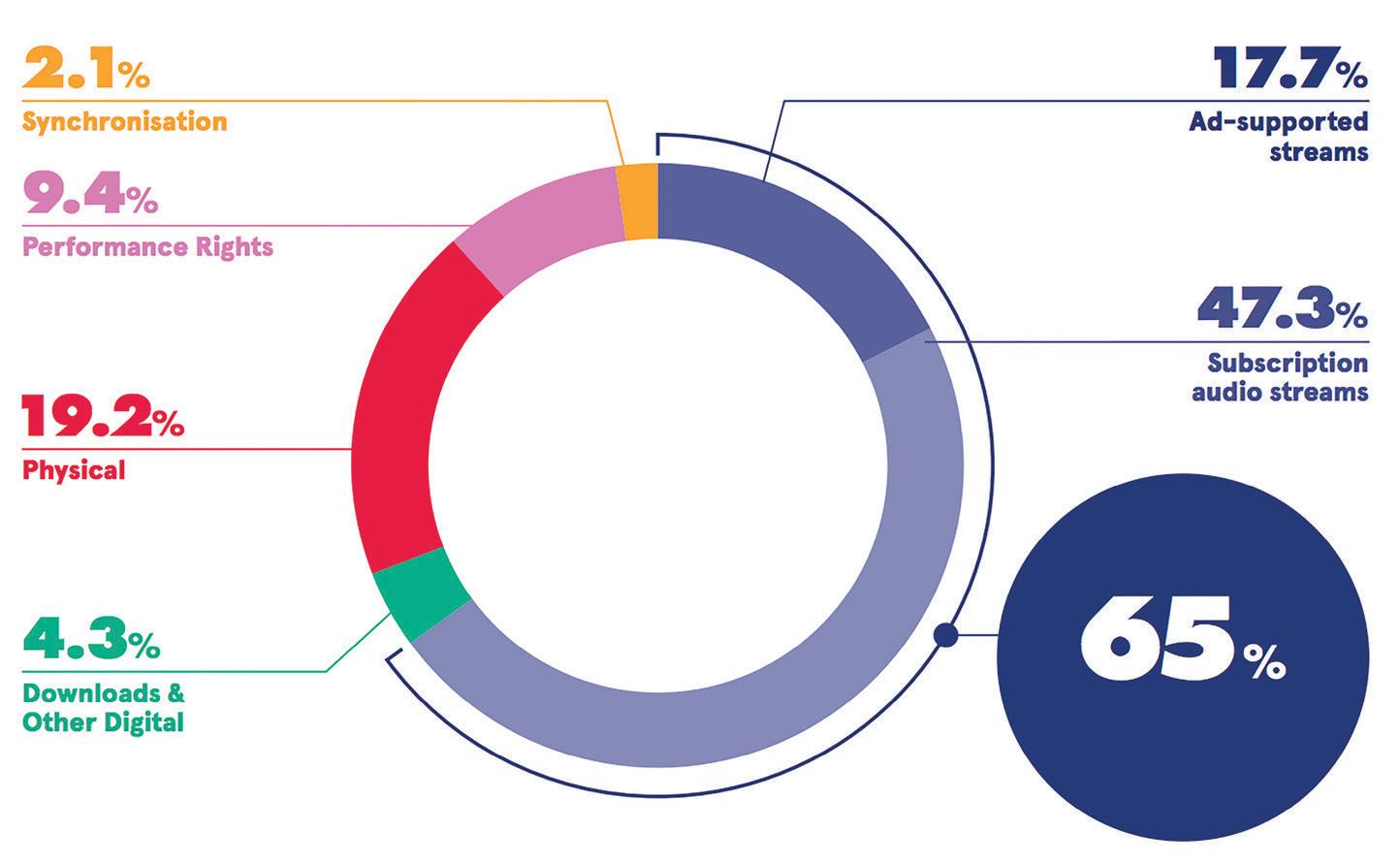
“In 2021, the global recorded music market grew by 18.5 per cent – a marked increase on the prior year’s growth rate (over 7.2 per cent),” states the IFPI report. “Once again, streaming – par ticularly paid subscription streaming – was a key driver of the overall growth. The dominant revenue format globally, streaming accounted for 65 per cent of recorded music revenues, up from a 61.9 per cent share in 2020.”
With 31 per cent of the market share, Swedish firm Spotify is the largest audio streaming platform in the world and counts Apple Music, Amazon Music, YouTube Music, SoundCloud and Deezer amongst its competitors. Since its launch in 2006, Spotify has paid out over $30bn in royalties to the music industry, includ ing a record-breaking $7bn last year.
According to Spotify data, over 50,000 artists generated $10,000 through the streaming platform last year and, for the first time ever, over 1,000 artists gener ated over $1m.
“Not only is streaming driving record revenues for the music industry, but there are also more artists sharing in that success than ever before,” said Spo tify founder and CEO Daniel Ek, claiming that the company was making “further meaningful progress toward a more vibrant and diverse music industry”.

Pointing out that 25 per cent of all sales went to the top 50 artists in the CD
era, Ek added: “On Spotify, that number has now been halved, with only 12 per cent coming from the top 50. The fig ures we’re sharing show that Spotify is improving on the music industry of the past, and more and more artists are able to stand out in the streaming era.”
Meanwhile, YouTube is gun ning for Spotify’s crown. It paid out over $6bn to the music industry between July 2021 and June 2022 – a $2bn year-onyear (YoY)increase. YouTube’s global head of music Lyor Cohen said: “We want our twin engine of ads and sub scriptions to be the number one contributor of revenue to the industry by 2025.”
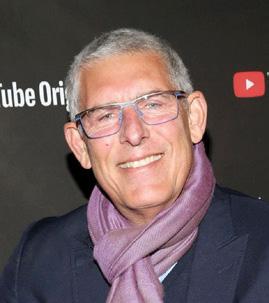
With “exceptional revenue growth” of 35 per cent, the Middle East and North Africa emerged as the world’s fast est growing region for recorded music revenue in 2021, according to the IFPI’s report. Reflecting on the region’s rapid growth, Moe Hamzeh, managing director, Warner Music Middle East, says: “Growth has come from increased DSP
[digital service provider] subscription numbers, but also from a rise in social media consumption and the increased importance of music on platforms like TikTok, Snapchat, Instagram Reels and YouTube Shorts – these are now pillars in people’s music discovery.”
Indeed, in March, short-form video hosting service TikTok launched SoundOn, an “all-in-one platform for music marketing and distribution, designed to empower new and undiscov ered artists, helping them develop and build their careers”. Operational in the US, UK, Brazil and Indonesia, SoundOn allows artists to upload their music directly to TikTok and begin earning roy alties. Closer to home, developments in the MENA region’s music industry have unfolded at an accelerated pace in recent years, with several UAE compa nies spearheading change.
Headquartered in Abu Dhabi, streaming platform Anghami –the first Arab tech company to float on the US stock exchange –posted a total revenue of $35.5m last year, an increase of 16 per cent on 2020. With 19.5 million active users, Anghami’s positive trajectory continues with the company reporting H1 2022 revenue of $21.1m –up 29 per cent YoY.
Furthermore, Anghami partnered with Sony Music Middle East to launch
RECORDED MUSIC REVENUES BY SEGMENT 2021TOTAL STREAMING
NOT ONLY IS STREAMING DRIVING RECORD REVENUES FOR THE MUSIC INDUSTRY, BUT THERE ARE ALSO MORE ARTISTS SHARING IN THAT SUCCESS THAN EVER BEFORE
Daniel Ek , founder and CEO, Spotify
the Vibe Music Arabia record label last year. With the objective of evolving from a music streaming platform to an entertainment platform, Anghami also acquired events and concert company Spotlight Events in July, claiming the acquisition would unlock synergies and opportunities between the physical and digital worlds.
“While Spotlight Events will provide a stage for artists to perform and reach their audiences offline, Anghami’s technology will bridge the gap between the offline and online worlds by providing access to exclusive concerts through its live video streaming capabilities and creating immersive experiences through AR and VR,” said Anghami in a statement.
However, with musicians calling for reforms and fairer pay in the streaming economy – Spotify pays artists an average of $0.0033 per stream – two UAE firms are amongst those determined to disrupt the status quo by harnessing emerging technologies.
Talal Alafghani, co-founder and COO of NIFTY Souq, the MENA region’s first and largest NFT marketplace, believes that NFTs – nonfungible tokens – have the potential to
revolutionise the music industry, a sentiment shared by EDM giant Steve Aoki. Labelling himself “a futurist”, Aoki said earlier this year that he’d made more money from NFTs than from 10 years of music advances. Using Ethereum and Polygon blockchain and smart contracts, NIFTY Souq’s objectives are to build a bridge between artists, musicians and blockchain, support the growth of native crypto NFT artists and o er low minting costs for all creators launching NFTs on the platform, thus helping the artists set a ordable prices.
“In today’s music industry, many artists are tied to intermediaries like music labels and streaming platforms,” explains Alafghani. “NFTs give the creators complete control and ownership of their creations. They can independently release their music to the public and sidestep the middleman. With this new technology, artists are reclaiming full ownership of their work. They can sell music NFTs directly to their fans and earn money from secondary market resales.
“The incentives are high for artists to use NFTs to publish and sell their work and the industry is already starting to move in that direction,” adds Alafghani. “At this pace, I believe streaming services will no longer dominate the music industry by 2030.”
Launched last year as a marketplace and auction platform for creating, selling and buying NFTs, NIFTY Souq recently secured $1.5m first round seed investment, which will be invested in tech and expanding the business.
Described as “a solution to common problems in the music industry as a whole”, UAE-based firm AudioSwim is an NFT music ecosystem and digital music distribution platform that allows artists and fans to buy and sell NFTs and music royalties globally. Providing “digital services for the forward-thinking musician”, the company’s mission is to “leverage the latest technology and help artists have more creative freedom”, states founder Albert Carter.
AudioSwim allows fans to invest in artists at a grass roots level by buying a percentage of future royalties from a given release, with minimum buy-ins determined by an artist’s sales history. If the song becomes a commercial success, fans receive a slice of the royalties proportionate to their initial investment.
Looking ahead to 2030, Carter has bold ambitions. “We aim to be the number one digital music distribution company and music royalty platform on the planet,” says Carter. “We want to make NFTs more mainstream-friendly via our streaming platform and plan to blend online and o ine seamlessly by integrating the metaverse, virtual reality and augmented reality into how artist interact with their fans. Ultimately, by the year 2030 we will be recognised as the leading digital music community that springboards artist careers to the next level.”
Indeed, with blockchain, AI, the metaverse, gaming platforms and other emerging Web3 disruptors increasingly driving opportunities for fans to engage with music in new and increasingly diverse ways, the next big upheaval in the music business is firmly on the horizon.

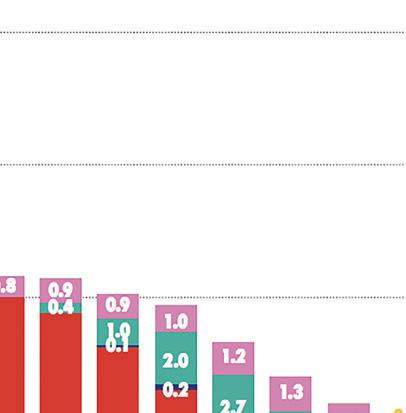
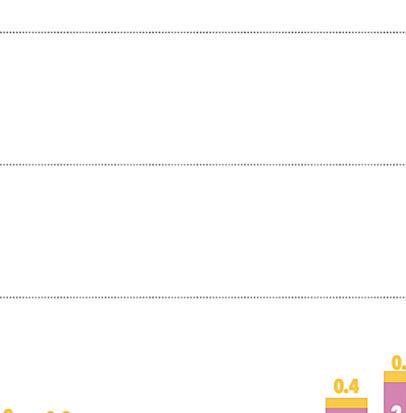











In September, 50,775 rental leases were recorded: 59.26 per cent were new leases while 40.74 percent were renewals


Of these, 88.56 per cent were annual contracts while 11.44 per cent were non-annual leases. 71.59 per cent were residential leases while 27.40 per cent were commercial leases
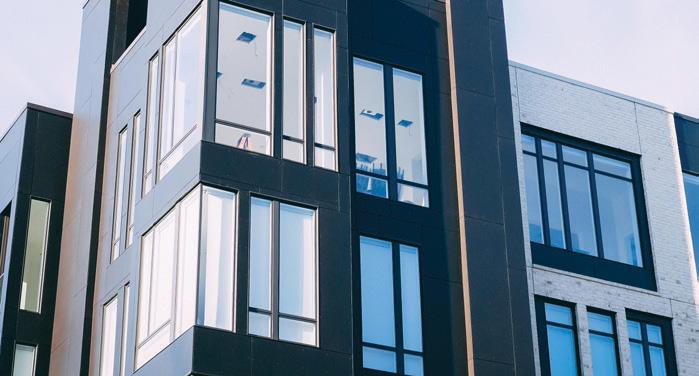


Q3
A total of 140,685 rental contracts were registered of which 58.71 per cent of contracts were new and 41.29 per cent were renewals
Of the total contracts signed, annual contracts comprised 87.33 per cent while 12.67 per cent were non-annual contracts
Business Bay 1976 Arjan 958 Downtown Dubai 870 Dubai Creek Harbour (The Lagoons) 771 Jumeirah Village Circle 645 Dubai Hills Estate 622 Mohammed Bin Rashid City 591 Meydan 461 Dubai Harbour 419 Al Furjan 383
Business Bay 998 Jumeirah Village Circle 671 Dubai Marina 655 Downtown Dubai 534 International City 497 Palm Jumeirah 378 Jumeirah Lakes Towers 329 Damac Hills (Akoya By Damac) 261 Dubai Creek Harbour (The Lagoons) 236 Dubai Hills Estate 224
SALES VALUE Dhs69,724,865,272
Total sales volume 25,456
2022 YTD (until Sept 30)
Dubai South (Dubai World Central) 500 The Valley 268 Town Square 175 Rukan 127 Villanova 113 Arabian Ranches 3 108 Mudon 82 Dubai Investments Park 74 Tilal Al Ghaf 42 Golf City 31 Damac Hills 2 (Akoya) 249 Al Furjan 127 The Springs 122 Arabian Ranches 112 Villanova 99 Arabian Ranches 2 95 Jumeirah Park 95 Dubai Hills Estate 90 Jumeirah Village Circle 82 Town Square 73
Sales volume O -plan 11,735 Ready 13,721
SALES VALUE Dhs24,416,764,991
Total sales volume 8,649 Sales volume O -plan 4,439 Ready 4,210
July to September 2022
2022
MORTGAGE
MORTGAGE VALUE Dhs59,431,932,279
Total mortgage volume 5,331

Mortgage volume O -plan 6 Ready 5,325
MORTGAGE VALUE Dhs22,186,849,149
Total mortgage volume 1,744

Mortgage volume O -plan 0 Ready 1,744


 WORDS: DIVSHA BHAT
WORDS: DIVSHA BHAT
There is no doubt that the United Arab Emirates (UAE), one of the most attractive markets in the Middle East, has been a major player in innovation and deployment of emerging technologies with both the public and private sectors playing a significant role. Due to the strong National Visions, businesses in the region have made tremendous progress in developing a digital infrastructure that promotes innovation and provides new economic opportunities.


With tech developments advancing at rapid pace, Gitex Global, in its 42nd edition showcased some of the top technologies, including cloud computing, artificial intelligence, fintech and blockchain, to name a few. The five-day event that was held from October 10-14, 2022, witnessed over 5,000 exhibitors, and more than 800 startups from over 170 countries.

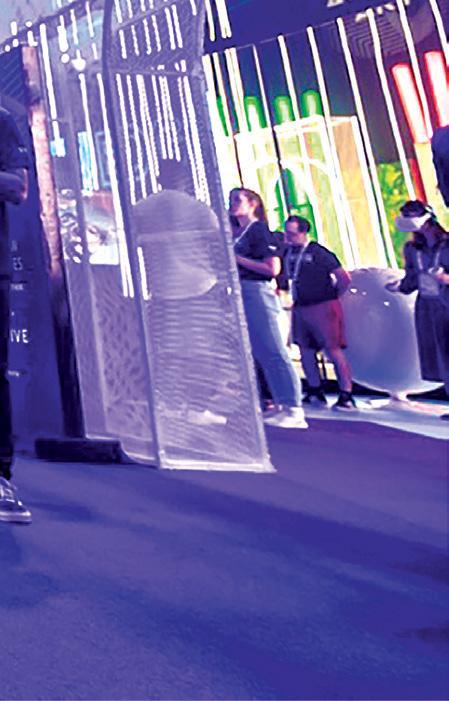
The Gitex 3.0 edition featured seven tech themes: North Star Dubai startups, Ai Everything, Future Blockchain



With government initiatives propelling the UAE to the forefront of the global digital economy, Gitex Global 2022 reflected the digital transformation ambitions of the UAE and the region
The X2 produces zero carbon dioxide emissions during flight, and is designed with low-altitude city capabilities in mind, reaching a maximum flight speed of 130kms per hour. We believe this advancement takes us one step closer to the future of short-distance city journeys taking advantage of this technology, including sightseeing and medical transportation”
“The year is associated with many transformative trends like metaverse and third generation web technologies that are unknown, amorphous and bourgeoning,” added LohMirmand. “These and other frontier techs can only finally impact our societies when there’s large scale expert discourses, collaborations and experimentations by protagonists and detractors. This is Gitex 3.0, where the decentralisation of the economy puts the power in the hands of every delegate in Gitex to participate in the shaping of our urban future.”
Summit, Fintech Surge, Marketing Mania and two new launches – X-verse, one of the immersive metaverse journey’s featuring 28 experiential brands and Global DevSlam, the Middle East’s largest ever coder and developer meetup.
Omar Al Olama, Minister of State for AI, Digital Economy and Remote Work Applications, who delivered the welcome note at the event, highlighted that the Global DevSlam event is poised to be one of the biggest developer events in the world.
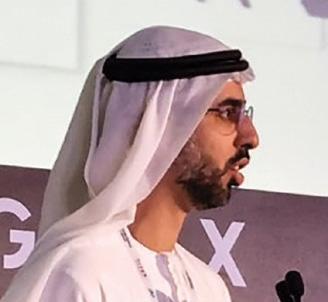
Meanwhile, Trixie LohMirmand, executive vice president of Events Management at Dubai World Trade Centre, Gitex Global’s organiser, said in a press conference, “Gitex serves a profound purpose of enabling and accelerating the digital economies of UAE and many of its alliance partners through connecting earnest stakeholders with outstanding minds from the world, and materialising these connections into actionable partnerships.
One of the key attractions at Gitex Global this year was the eVTOL flying car X2. Xpeng, a tech company and EV manufacturer that designs, develops, manufactures and markets intelligent mobility solutions, designed the two-seater eVTOL flying car X2. It is equipped with an intelligent flight control system and autonomous flight capabilities and is the latest generation of flying cars developed independently by the company’s a liate Xpeng Aeroht.
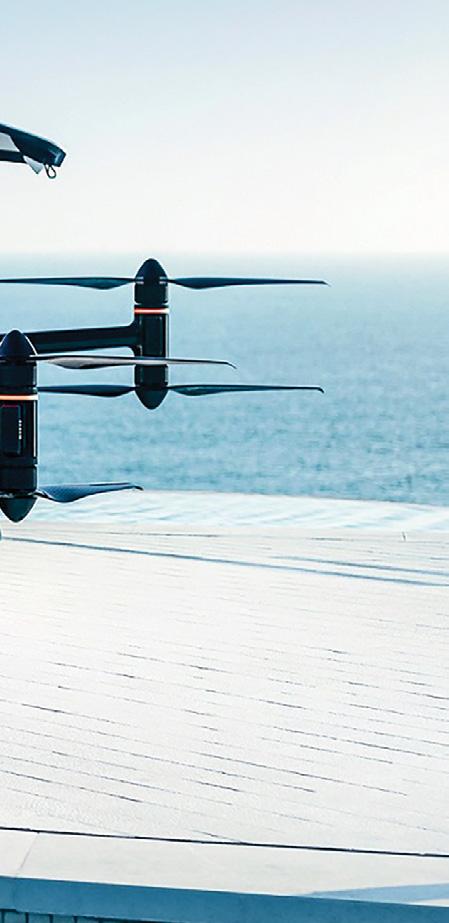

Dr Brian Gu, vice chairman and president of Xpeng, said the X2 produces zero carbon dioxide emissions during flight, and is designed with lowaltitude city capabilities in mind, reaching a maximum flight speed of 130kms per hour.
“We believe this advancement takes us one step closer to the future of short-distance city journeys taking advantage of this technology, including sightseeing and medical transportation,” he said.

This year, Gitex Global saw a 52 per cent growth in the number of new exhibitors and witnessed North Star hosting the biggest Unicorn meetup with 35 Unicorns from 15 countries. The

‘Africa Fast 100’ programme presented the largest ever gathering of African startups to be hosted outside Africa.
A number of debut international exhibitors like Binance, Ooku, AMD, Tencent, Bytedance and FTX Exchange, also participated in the tech show.
There was an array of announcements made at the show by leading technology companies and government organisations that included the introduction of innovative solutions, the formation of new technology partnerships, as well as plans for further expansion.

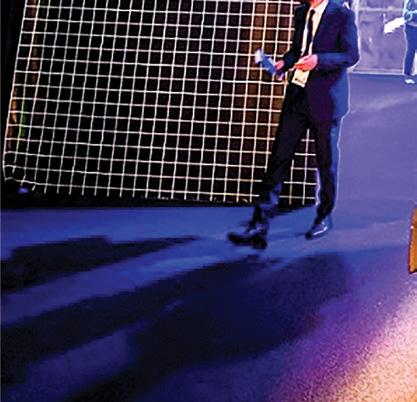




For instance, TAMM, the Abu Dhabi unified government services ecosystem, in cooperation with the Abu Dhabi Police, launched ‘Drive A Car’, an integrated digital journey that enables customers to access all the information and services that are associated with driving a car in Abu Dhabi.
Services available under this platform include submitting applications to issue or renew a driver’s licence, purchasing a new or used car or managing vehicle-related services such as paying fines, registering or renewing car ownership.
Meanwhile, the health information exchange platform, Mala , the Department of Health – Abu Dhabi launched the Mala Health Portal that seeks to provide the emirate’s community members with a convenient and secure access to their centralised medical records. Through the portal, patients

can access the latest information related to their doctors’ visits, laboratory results and radiology reports, medications and more.
Furthermore, Dubai Municipality signed two contracts with Ordnance Survey, Great Britain’s national mapping agency to benefit from global geospatial expertise in accelerating innovation and contributing to the development of fundamental services for citizens, residents, and visitors in Dubai.
The partnership will aid in developing and governing the construction system for Dubai. The survey will support the Building Regulation and Permits Agency in Dubai Municipality to improve services for customers and stakeholders in the building and construction sector in the emirate.
Additionally, the Department of Government Support represented by the Abu Dhabi Digital Authority (ADDA) announced the launch of the Abu Dhabi Data Program. The programme aims to deliver a data-driven transformation for the Abu Dhabi government to make data more available and accessible.
G42, the UAE-based artifi cial intelligence and cloud computing technology company, exhibited the breadth of its technology ecosystem at Gitex Global. In its debut, G42’s operating companies showcased latest products and solutions across different industries, from energy-effi cient data centres to AI-powered geospatial intelligence
It focuses on all aspects of data management from building the data capabilities and skillsets, activating and building of data foundations across government sectors, deploying the necessary regulatory data toolkits, developing sectoral executive dashboards to be consumed at the top of government, and improving the maturity of data management across the Abu Dhabi government entities.
The programme also aims to empower the Abu Dhabi government entities to accelerate their data journeys, build and attract the right skills, and provide a unique toolkit of regulations, resources, and assets to ensure the value of data is realised.
Along with the public sector, the private sector has also taken major steps in creating a robust digital infrastructure that fosters innovations and opens up new opportunities. Gulf Business spoke with regional professionals to understand how the technology industry is evolving in the Middle East and hear about the new products and services set to disrupt the landscape.
CLOUD: Cloud computing is proliferating in the Middle East as many organisations are moving their processes and data to the cloud. Gartner estimates that end-user expenditure on public cloud services in the Middle East and North Africa region will reach $5.7bn in 2022.
Talal Al Kaissi, CEO of G42 Cloud believes that currently every single company or government organisation is starting to embrace cloud. “There was inherent resistance earlier that the cloud is less secure, or cloud will displace jobs, but neither of them are true.”
G42, the UAE-based artificial intelligence and cloud computing technology company, exhibited the breadth of its
technology ecosystem at Gitex Global. In its debut, G42’s operating companies showcased latest products and solutions across different industries, from energy-efficient data centres to AI-powered geospatial intelligence.

“Our cloud infrastructure is designed to make organisations more intuitive, agile and efficient to solve real-world challenges. G42 Cloud operates its cloud platform end-to-end, having built best-in-class intelligent data centre facilities across the UAE. Our cloud solution was born out of a need. The need was how do we provide AI solutions that we are doing in a more scalable way? We had to build cloud because the use case required sovereignty,” said Al Kaissi.
Meanwhile, Genesys, the American software company also sees a major shift with businesses in the region reinventing customer experience by adopting emerging technologies.
“Cloud acceleration in the Middle East has been growing in the last two to three years because of the Covid-19 pandemic. We have witnessed IT departments and organisations embrace this technology,” said Evren Aker, director of Partnerships – Middle East, Turkey and France at Genesys.

At the event, the company showcased its Multicloud CX, the enterprise contact centre software. “The solution allows enterprises to unify voice and digital channels, self-service, work items, and inbound and outbound interactions through native capabilities and integrations so that businesses can create holistic, personalised experiences,” added Aker.
Furthermore, Snowflake showcased how its data cloud can help organisations unlock and mobilise their data. “The cloud-native architecture of our data cloud allows us to address the challenges and opportunities faced by a wide
Visitors at Gitex Global 2022 Evren Aker, director of Partnerships –Middle East, Turkey and France, Genesysrange of industries, including healthcare, media, finance, retail and manufacturing. Our platform allows companies to build applications directly on top of it, monetise their data-intensive applications and deploy them directly in the data cloud. By using Snowflake as the basis for application development, users will be able to easily enable discovery and collaboration throughout their organisation,” explained Mohamed Zouari, general manager, Middle East, Turkey and Africa at Snowflake.
DIGITAL TRANSFORMATION: Experts at Gitex Global also highlighted how digital transformation has played a key role across various sectors in the region.
Autodesk, an American multinational software corporation that makes software products and services for the architecture, engineering, construction industries exhibited its Forge platform, which offers a set of application programming interfaces (APIs) to empower creators to build innovative cloud-powered applications and become strategic enablers of the UAE digital economy.
“Autodesk platform services essentially is a way of choosing a cloud-based services platform, which offers a set of APIs, allowing customers to build innovative solutions and customisable workflows,” said Mohammad Saleh, regional manager at Autodesk.

“Forge tools help companies build applications that tap into their design and engineering data. From automated processes to alerts. 3D in-browser to virtual reality. Forge APIs can be combined with existing software systems to innovate how you work and get more from your data.”
Meanwhile, Honeywell demonstrated how technology solutions can empower retailers, make supply chains faster and more agile, transform distribution centres and enhance the future of healthcare.
“Our solutions including handheld mobile computers, voice directed work and other productivity solutions enable mobile workers to efficiently execute tasks and access businesscritical data,” commented Roman Poludnev, GM – Safety and Productivity Solutions – META at Honeywell.
The company also showcased how its healthcare technologies enhance operations and automate patient data entry through a mobile communication platform and optical character recognition scanners.
CYBERSECURITY: Many futuristic ideas and solutions were demonstrated during the tech show; however, cybersecurity was a vital topic that was compelled by them.
According to Kaspersky cyberthreats are increasing everywhere in the world, and especially our region due to geopolitical and financial gains reasons. “There is an increase in ransomware attacks. Some of the key verticals that are targeted are the public and financial sectors. We also see a lot
of attacks on the industrial network such as small factories or critical networks such as electricity and water supply or sewage supply,” observed Amir Kanaan, managing director –META, Kaspersky.
“Cybercriminals’ attacks will continue to grow exponentially in both sophistication and volume. Nevertheless, we can drastically mitigate the risks and consequences of cyberthreats, which are an inevitable part of the digital era we’re living in. In the evolving threat landscape, we believe that the concept of traditional cybersecurity will soon become obsolete. This is why a new approach is required to better counter cyberthreats,” he added.
Kanaan believes that the most efficient solution to this challenge is a security-by-design approach, or ‘Cyber Immunity’ – the inclusion of security mechanisms from the very first stage of a device, so that the cost of a successful attack is always greater than any potential benefit cybercriminals may gain from an attack’s potential success. “This implies that the risks posed by entire classes of cyberattacks will be eliminated: they can no longer affect a system’s ability to execute its functions.”
“Cybersecurity solutions must be able to see across every corner of the enterprise, offer rapid and efficient protection across the organisation, and offer an automated response across the connected security ecosystem,” commented Tamer Odeh, regional sales director at SentinelOne.

Meanwhile, Hani Nofal, vice president of Digital Infrastructure Solutions at Gulf Business Machines (GBM), explained that there has been a rise in complexity due to lack of qualified skills. “We are struggling to find qualified resources and that is adding to the problem.”
He also added that there is a huge shift in the security industry to what we call the zero-trust approach. “The whole industry is moving towards zero trust which means we trust nothing. We should always verify and always need to check.”
The Gulf Cooperation Council, has always been ahead of the game in terms of technological innovation and adoption compared to other parts of the world. The growing demand for local IT companies, technologies and projected investments will strengthen the region’s economy.
Platforms such as Gitex Global have become vital for organisations to showcase solutions in data, and cybersecurity – all of which have been carefully crafted to further enhance the capabilities of this region in terms of digital transformation.
Going ahead, the region seems to be on its way to becoming an increasingly prominent player in the technology landscape.













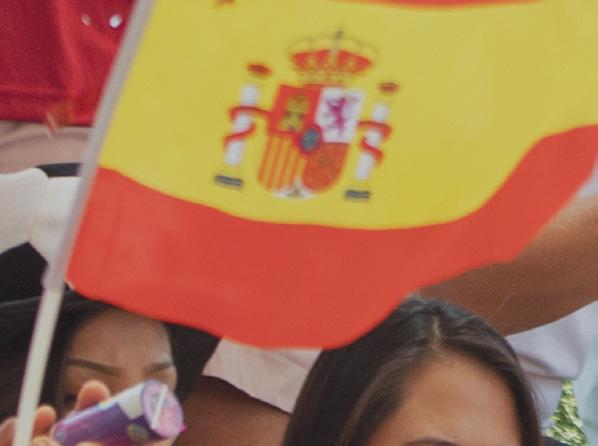
















At Gitex Global this year, we spoke to Morad Qutqut from Hewlett Packard Enterprise (HPE) and Sajeev Perunnelly from Alpha Data, who provided an insight into the scope of cloud-based technologies
 WORDS: ZUBINA AHMED
WORDS: ZUBINA AHMED
across hybrid cloud in your own environment, as a software-defined platform. It’s a flexible, open and secure platform that powers datafirst modernisation, wherever applications and data reside.
At Gitex, visitors were able to explore the platform, guided by HPE experts on-site and take a test drive.
Exascale technology allows ultra-powerful supercomputing and HPE offers the most comprehensive end-to-end portfolio in the HPC and artificial intelligence (AI) segments. Visitors were able to find out more about Frontier, Oak Ridge National Laboratory (ORNL) supercomputer, built by HPE. Moreover, our digital advisors offered 45-minute one-to-one sessions to explore visitors’ digital journeys and advise on next steps. The sessions looked at their digital journey and its implications on technology across the edge to cloud landscape.
In the UAE, what is the scope of cloudbased technology? In what ways can this technology benefit companies?
In the UAE, we see a huge demand for cloudbased technology. There are different providers,
What were the main technological solutions you provided at Gitex Global?
HPE showcased industry-leading solutions from Edge to Cloud, with HPE GreenLake leading the way, along with an Exascale demonstration and a Mercedes Formula 1 simulator at Gitex Global this year. HPE GreenLake offers unified cloud services, providing a seamless experience
“IN THE BEGINNING, EVERYONE WAS THINKING ABOUT CLOUD FIRST STRATEGY IMPLEMENTATION, WHEREAS NOWADAYS THE LEADING STRATEGY IS DATA FIRST”
MORAD QUTQUT chief customer innovation officer for Strategic Customer Engagement – HPE
public, local and certain services that they can run inside their data centre. The big question is, how they can combine these di erent o erings and flexibility across a single control panel that will allow them to consume these different services in a timely manner. And here is where HPE comes into play. We have the solution to help our customers accelerate their digital transformation journey.
In the beginning, everyone was thinking about cloud first strategy implementation, whereas nowadays the leading strategy is data first. With this, we provide customers with the same experience from edge to cloud as well as flexible payment solutions.
Can you elaborate on how HPE provides the best cloud-based solutions?

We have customer references in manufacturing, government and others. To support customers in their digital transformation and business outcomes, and guide them throughout their cloud journey, we came up with ‘HPE Digital Life Garage’ in Dubai that is open to the whole of the Middle East.
This programme is mainly aiming to help customers from the very early stage of brainstorming to measuring outcomes. All this is built as a service on the HPE GreenLake platform.
We are supporting the ecosystem of innovation in the UAE and we are helping government and private sector customers to move on with these ideas to support their business. We are working closely with channel partners like Alpha Data and technology leaders like Intel, Microso t, VMware, Nvidia, as well as startups to support this. As the leading edge-to-cloud service provider, we believe we have a lot of scope for customers across the region.
What were the main technological solutions







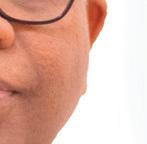



Alpha Data provided at Gitex Global?



Alpha Data is one of the largest partners of HPE in the UAE and our strategy is well-aligned with the company. When it comes to infrastructure, we cover everything from device to cloud. We also have a dedicated business practice for digital transformation, cybersecurity and helping our customers in cloud adoption.


During Gitex this year, we showcased a wide range of practices, technologies and trends that covers data, AI, internet-of-things and
SAJEEV PERUNNELLY director – Enterprise Computing, Alpha Data


automation. When it comes to infrastructure, our focus areas is development operations. We also demonstrated our capabilities and skills on some of the emerging trends such as the metaverse. Our key takeaway from the event is an unprecedented interest from our customers in digital transformation and their inclination for consuming technology as a service.
What types of cloud-based infrastructure and solutions does your company provide?




We have a dedicated cloud-first team that helps customers with the entire journey of cloudadoption. We o er them a one-stop solution from consulting and migration, to managed services for cloud infrastructure and optimisation of cloud consumption. With our deep expertise and our partnership with large technology companies, we have transformed from an onpremises infrastructure system integrator into a cloud system integrator. We also help our customers with cloud adoption in any form that their business demands – be it public, private and hybrid cloud options. When it comes to private and hybrid cloud option, HPE’s GreenLake plays a vital role in our cloud story.

“TO SUPPORT CUSTOMERS IN THEIR DIGITAL TRANSFORMATION AND BUSINESS OUTCOMES, AND GUIDE THEM THROUGHOUT THEIR CLOUD JOURNEY, WE CAME UP WITH HPE DIGITAL LIFE GARAGE”
“OUR KEY TAKEAWAY FROM GITEX THIS YEAR IS AN UNPRECEDENTED INTEREST FROM OUR CUSTOMERS IN DIGITAL TRANSFORMATION AND THEIR INCLINATION FOR CONSUMING TECHNOLOGY AS A SERVICE”
The Department of Government Support, which is represented by the Abu Dhabi School of Government and the Abu Dhabi Digital Authority, launched the Data Academy at Gitex Global. The project is aimed at developing the skills of government sector employees in the field of data. This initiative is also aimed at enhancing the performance of government entities, as well as helping build capabilities and improve their efficiency.
The Data Academy will offer government workers specialised training programmes and courses in the field of data management. A key focus of the academy’s programmes will be to educate employees about the basics of data and how data value can be realised.
As a result of this project, a higher data maturity index will be the target of government entities in Abu Dhabi. It is also expected that the academy will contribute to the digital agenda of the emirate and enhance its position as a leading centre for the management of data in the region.

The Data Academy is part of the Abu Dhabi Data programme, which aims to bring about a databased transformation to enhance and accelerate government performance, enable government entities to make decisions based on sound visions and data analytics, and develop individual capabilities of government entities employees and make them more impactful.
Du du, from Emirates Integrated Telecommunications Company (EITC), presented an innovative showcase under the theme ‘Powering Governments, Shaping The Emirates Reality’. The telco had a significant presence at the event with the signing of key strategic partnership agreements and display of technologies including internet-of-things, augmented reality, metaverse and robotics.
At the tech show, they collaborated with the Abu Dhabi Department of Economic Development, the Dubai Electricity and Water Authority and the Roads and Transport Authority to support the UAE government’s innovation roadmap.

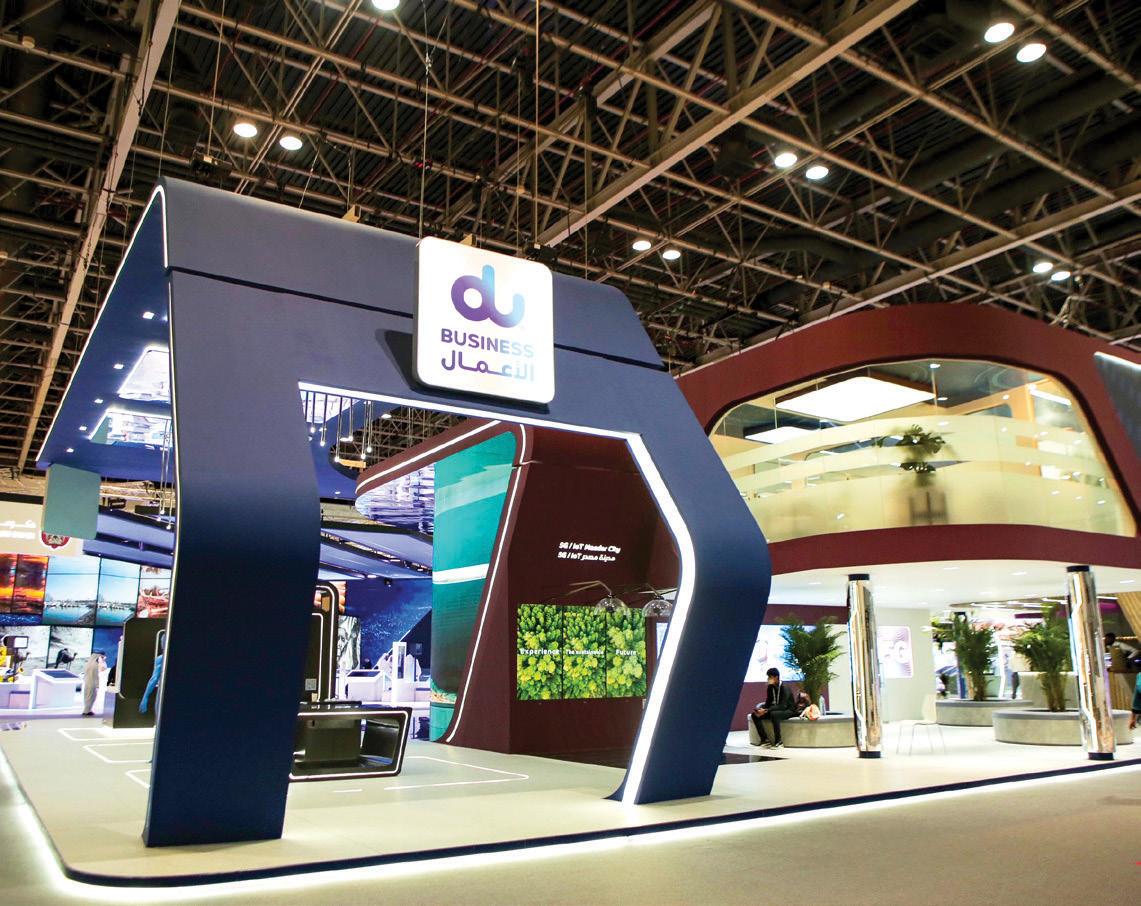
In addition, du signed a memorandum of understanding with Emirati Talent Competitiveness Council related to the Nafis programme, a federal initiative aimed at
increasing the contributions of Emirati citizens within the private sector.
Du’s presentations included the transport reality with the digital twin solution, the health and education reality in metaverse powered by a 3D hologram, the industrial reality featuring 5G-enabled robotics and the utilities reality powered by smart grids.
With an intense focus on boosting the IT security, communications and technol ogy industries in the Middle East region, UAE-based Bulwark Technologies, one of the IT specialised value-added distributors showcased an array of products at Gitex Global.
The company reiterated the impor tance of building a strong, integrated security infrastructure in the region. “As remote work is becoming a more prevalent trend in business and considering the recent Covid-19 outbreak, there’s no better time for employees and companies alike to make strides in secur ing remote work,” says Jose Thomas Menacherry, managing director at Bulwark Technologies.
The distributor announced major partnerships and demonstrated products and solutions like enterprise email security, endpoint prevention, detection and response, to name a few. Menacherry also shed light on Bulwark’s collaboration with key vendors in the Middle East Region. “Our strategy for exhibiting at Gitex was two-fold. Aside from showcasing innovative technologies gaining traction in the region, we also introduced cutting-edge technologies, that are popular globally.”
Nozomi Networks, the operational technology and internet-of-things (IoT) security company educated visitors about growing vulnerabilities in operational technology and information technology systems.
The company sees a strong increase of cyberattacks specifically in the IoT networks in the region. “Whenever you go into a mall or a building, you’ll see heating, ventilation, and air conditioning. A lot of these networks and devices are hammered completely, without any protection. So that’s a big driver for increasing the cybersecurity pos ture,” comments Marcus Josefsson, VP – EMEA at Nozomi Networks.
At the event, the company showcased how it can facilitate and support the industrial and government organisations by protecting their critical infrastructure from existing and emerging cyberthreats. It introduced its Threat Intelligence Feed subscription service, which allows
customers to leverage a single, unified feed of threat intelligence across other layers of their security stack, once they have subscribed.
“We have the professional services teams who are extremely responsive and that’s something that people in this region care about. You might have a great solution but if you don’t have local support for that solution, it becomes problematic. As part of their digital evolution, organisations must secure their digital assets against all manner of local and global cyberthreats,” adds Josefsson.
Mandiant, the cybersecurity firm believes that effective security is not only based on the technologies businesses have in place, but also on the expertise and intelligence behind them. The company presented its Mandiant Advantage software-as-aservice platform which it says delivers intelligence to security teams.
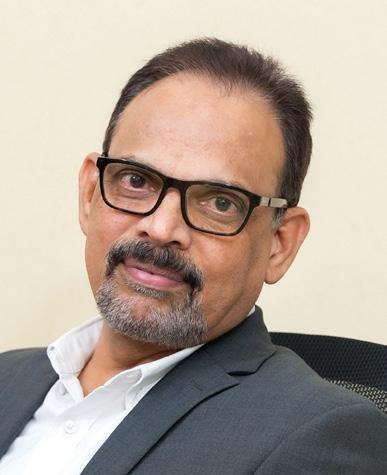

Jamil Abu Aqel, systems engineering director – MEA at Mandiant, explains how the company looks forward to engaging with its customers, partners and other firms that are looking to improve their cybersecurity posture. “We have a deep understanding of the threats and the tactics, techniques and procedures of hackers which are rapidly changing. In terms of security, we believe that it is not only crucial that you have the right technologies in place, but also that the right expertise and intelligence behind those technologies. Our goal is to assist organisations in implementing more effective and efficient cybersecurity strategies and to help them develop a greater sense of confidence in their abilities to defend against and respond to cyberthreats.”

“WHENEVER YOU GO INTO A MALL OR A BUILDING, YOU’LL SEE HEATING, VENTILATION, AND AIR CONDITIONING. A LOT OF THESE NETWORKS AND DEVICES ARE HAMMERED COMPLETELY, WITHOUT ANY PROTECTION”
Automating processes enables employees to offload repetitive tasks, increasing their productivity and allowing them to spend more time innovating and growing the business
Shed some light on the global automation market progression and its growing opportunities in the Middle East. Robotic process automation (RPA) started to emerge in the late 90s, comprising tools such as web scraping, workflow automation and early generation artificial intelligence. The solu tion was known for automating repetitive, back office tasks.
RPA became more “mainstream” in 2015 but even at that time, it still remained very much back office focused.
During the Covid-19 pandemic, due to the great resignation and macroeconomic pressures, among other factors, RPA reached a maturity and is now being adopted company-wide.
Automation economy is accelerating the dig ital transformation efforts of businesses across the Middle East. IDC research shows that 49 per cent of Middle East’s chief information offic ers (CIOs) have brought forward their digital agendas by at least one year – and 14 per cent by almost two years – following the upheaval of 2020.
Many of these CIOs are now actively reviewing and exploring new digital business models and ecosystem partnerships for the long term.
How are you helping businesses in the Middle East? Can you share some use cases?
Our current focus in the region is the UAE and Saudi Arabia where digital transformation agen das are robust and continue to scale.
At present, our customer list consists of gov ernment and financial services sectors.
For instance, ANB (Arab National Bank) has automated 35 manual repetitive business pro cesses within the bank using Automation 360, the cloud native, AI-powered RPA platform.
Raj Mistry, executive vice president – Europe and the Middle East, Automation Anywhere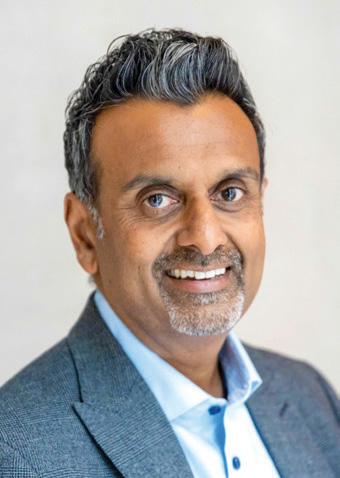
More than 100 software bots now perform tasks within the bank’s operations, compliance, HR and other departments. Overall, ANB has completed more than two million requests saving 40,000 hours of manual work.
Meanwhile, in Network International, auto mation has spread to over 70 processes and more than 150 sub-processes and 120 bots in produc tion. There has been 70 per cent reduction in manual processing time and chargeback requests are automatically processed.
Tell us about your participation at Gitex Global. At Gitex Global, we launched the Automation Success Platform which is designed to help enter prises engage with employees, connect disparate applications, whether cloud-native or on-prem ise enabling business growth and workforce productivity.
The new solutions include Document Automa tion, AARI for Every App, CoE Manager, Citizen Development, Process Discovery, and the Auto mation Pathfinder Program.
What is your business and technology forecast over the next 24 months? Digital transformation and the intelligent enter prise: Developments and further investments in AI, the internet-of-things, virtual and augmented reality, cloud computing, blockchain and superfast network protocols like 5G - these technologies will start to work so closely together that the lines will be blurred; this will be the beginning of the “intelligent enterprise”.
Employee experience (EX) and customer expe rience (CX): Technology will continue as a beacon to help businesses better connect with customers. Flawless and streamlined transactions will be key to the customer experience. In addition, in order for CX to work, you have to have strong EX as the foundation happy employees create happy cus tomers. Overall, both employees and customers are expecting streamlined processes that remove roadblocks and friction.
Talent challenge and workforce transforma tion: Much of what we are experiencing today will continue for the next two years. Labour shortages as a result of the great resignation, quiet quitting, and great retirement, employers are under pressure to provide attractive careers, flexibility of hybrid work and offer employees fulfilling work. This means that humans will increasingly share their work with bots – soft ware and smart robots.
Tell us about the importance of being at Gitex Global.
We were at Gitex Global to meet our partners and customers, to understand their business requirements and assist them in their cloud journey. We focused on the key areas such as cloud, artificial intelligence, data protection and security, channel and partners, and sustainability.
Our focus at the event was also our cloud solutions and our partnerships with cloud providers such as AWS, Microsoft Azure and Google Cloud. We collaborated with them to deliver native solutions in their clouds.
Migrating an entire on-prem IT infrastructure to
the cloud is a huge challenge. It means transforming the associated internal IT processes to support the operations, governance and compliance of the cloud-based environment. Also, upskilling people within the organisation to support that new environment takes significant amounts of time. In some instances, it can even be unrealistic to do so. For such organisations, the hybrid cloud approach can be much more suitable. For these customers, hybrid cloud provides the most business benefits at the cost of minimal transformational risk. The first step to hybrid cloud adoption typically involves identifying specific use cases that are suitable for transferring to the public cloud and producing an effective adoption strategy for each of these use cases. For example, identifying infrequently accessed data or development and testing, another common use case is disaster recovery. But then we need to consider challenges associated with that like getting insight into the data set, reducing migration complexity and costs and then gaining visibility and control into the data that is migrated to the cloud.
Similar to the hybrid cloud, multi-cloud adop tion has increasingly become popular over the

What are the challenges faced in cloud adoption?
Organisations looking to successfully adopt cloud computing should start with planning the clear requirements and the expected business outcomes
last few years, especially at the enterprise level. Multi-cloud adoption makes it possible to utilise specific technologies from each cloud platform while diversifying the risks of being tied down to one cloud platform. These bene fits have driven the adoption of the multi-cloud model, despite some of the operational chal lenges it can pose.
However, the challenges that come with multi-cloud adoption can include proprietary technologies by each cloud platform, the operational complexity for the IT teams to work across multiple cloud portal and challenges for application developers associated with proprietary application and compute platform associated with each cloud provider.
What are the market dynamics influencing cloud adoption?
The success of a cloud adoption can depend on understanding why your organisation needs to move to the cloud. Anyone looking to success fully adopt some form of cloud computing model
Walid Issa, senior solutions engineering manager, NetApp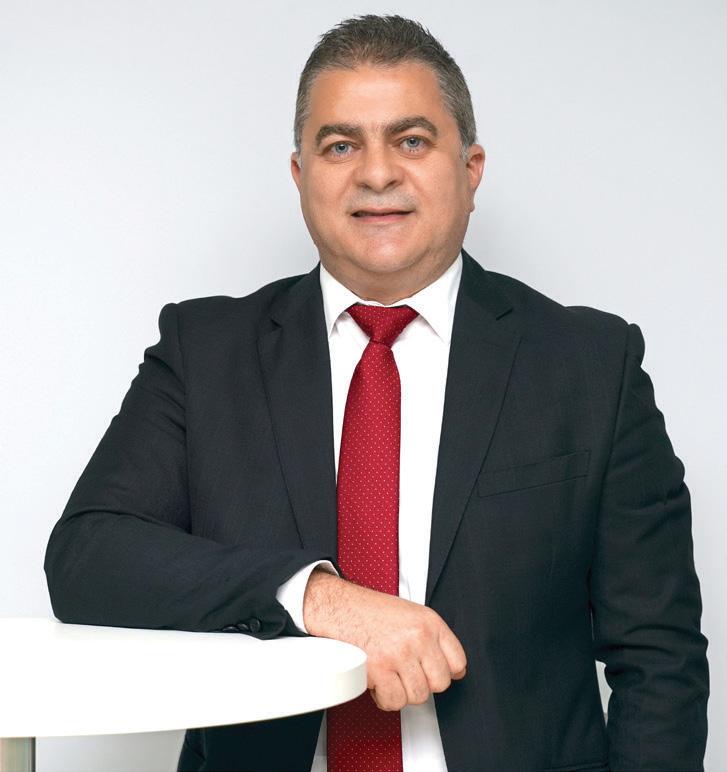
should start with establishing the clear business requirements and the expected business out comes. Many unplanned cloud adoptions can risk failure due to costs going out of control and other factors.
The best way to avoid such outcomes is to start with the “Why?” Why do you need to use the cloud?
Are the costs of on-premises deployment no longer scalable for your business?
Is your organisation looking to reduce business risk with the improved infrastructure reliability and availability of the cloud?
Are you trying to grow revenue by quickly creating new products and services and offering them to new markets through a geographically distributed public cloud platform?
Is your organisation looking to increase its operational efficiency and improved produc tivity by automated, self-serviceable cloud IT?
While every organisation’s answer will be differ ent, it is important to clearly establish, document and assess the business drivers that would under pin the adoption of cloud as the starting point to any form of cloud adoption plan and get the busi ness leader’s buy-in.
Tell us about your role in driving cloud adoption. We are uniquely positioned in the market with our long-term collaboration with public cloud providers. We provide a portfolio of services for running applications in these clouds that reduces cloud costs by up to 90 per cent. Our platform enables customers to run enterprise applications like SAP, Oracle, SQL and high-performance compute jobs – for example, in oil and gas exploration and genomics and cloud native applications like web apps.
In a partnership spanning nearly 20 years with Microsoft, we’ve jointly delivered innovative products that help organisations manage their data anywhere. Azure NetApp Files gives business data management with the performance, simplicity and cost savings you need to migrate your most challenging workloads to Azure.
Meanwhile, our partnership with AWS goes back nearly a decade. We have shared a determined focus to help our customers build solutions, reduce costs and innovate faster in the cloud. Furthermore, through our partnership with Google Cloud, we provide customers with agility, scalability and security – all the critical elements to drive our customers’ digital transformation needs.
“THE FIRST STEP TO HYBRID CLOUD ADOPTION TYPICALLY INVOLVES IDENTIFYING SPECIFIC USE CASES THAT ARE SUITABLE FOR TRANSFERRING TO THE PUBLIC CLOUD AND PRODUCING AN EFFECTIVE ADOPTION STRATEGY FOR EACH OF THESE USE CASES”
“WE PROVIDE A PORTFOLIO OF SERVICES FOR RUNNING APPLICATIONS IN THESE CLOUDS THAT REDUCES CLOUD COSTS BY UP TO 90 PER CENT”

with the Ministry of Health and Prevention (MoHAP) will provide a digital platform to cen tralise patient healthcare needs for patients and providers. The new solutions will prioritise per sonalised patient experience, enhance efficiencies across the sector, and contribute to the transforma tion of the healthtech industry.
The MoU will help MoHAP leverage our expertise to help explore an innovative phar maceutical supply chain solution platform as well, as a result of which the UAE population will be better protected and cared for and will see optimisation of the supply chain process, thus avoiding wasteful expenditure.
Further exploration and alignment with international industry organisations continue to mature, and examples include Singapore tech companies looking for deeper partnerships and knowledge sharing.
How are you addressing today’s organisations diverse technology needs?

Technology has transformed business operations in ways never seen before in history. Emerging technologies are helping companies across the globe improve their competitive advantage and drive growth. At Injazat, we leverage our 16 years of digital transformation experience through a broad ecosystem of partnerships and venture building to provide innovative solutions, help companies work better and increase efficiencies, creating safer societies and better living environments.
Co-creation, agile practices and design thinking are critical components of our approach. Our methodology offers us a platform by which we can provide evidence-based, industry-relevant and flexible solutions to meet the constant technological needs in a consistently changing world.
What was your focus at Gitex Global 2022?
Our focus at Gitex this year was to highlight our growing and dynamic partner ecosystem, leading to new technologies and increased capabilities, and to explore and demonstrate the impact of Web3.
Tell us about some of the key MoUs signed at the event.
We have fostered a great rapport with the coun try’s governing bodies and created trust-based relationships with our solutions. The MoU signed
Furthermore, we announced Nesma Injazat, the new joint venture in Saudi Arabia. Supporting industries such as healthcare, smart cities, cyber defence, energy, and construction, this new joint venture will be a pioneer in transforming the digital landscape of Saudi Arabia. This is but a start to our international expansion.
The partnership with The Arab Youth Centre supports the Arab Youth Technology Fellowship Program. Through a series of workshops and expert sessions, youth will have the opportunities to be mentored and trained in fourth industry revolution solutions such as AI machine learning, cloud and security. Creating an ecosystem that fuels industries towards progress and moulding the talent pipeline required for these industries is paramount, and at Injazat, we are committed to being the orchestrators of that ecosystem.
Tell us about your plans for 2023. With a newly reinvented brand identity, we plan to showcase the breadth and depth of our capabilities in the regional and global markets in the coming year. We want to reinvent the way people interact with technology.
Our goal in 2023 is to continue expanding, transforming, growing and partnering with corporations. Meanwhile, our goal as a technology solutions and digital transformation company is to continue delivering game-changing projects with quality and drive change through technology.
WE ANNOUNCED NESMA INJAZAT, THE NEW JOINT VENTURE IN SAUDI ARABIA. SUPPORTING INDUSTRIES SUCH AS HEALTHCARE, SMART CITIES, CYBER DEFENCE, ENERGY AND CONSTRUCTION
How does Injazat offer innovative solutions, help businesses in operating more effectively, and create a safer society? Martin Yates explains…













Guido Terreni, the CEO of Parmigiani Fleurier, is successfully carrying on the legacy of the small-batch independent luxury watchmaker p.60

“In terms of product o erings, 100 per cent of our plastic packaging will be refi llable, reusable, recyclable or compostable by 2025, and 100 per cent of the plastics used in L’Oréal’s product packaging will be either from recycled or bio-based sources by 2030”
















The new suitcase, inspired by the Northern Lights, is a limited-edition o ering, with only 1,000 numbered pieces produced by the company Laurent Du er, managing director of L’Oréal Middle East

position. But its clients were very knowledgeable, refined and understated. We introspected on our core aesthetic codes and were able to launch – in just a few months – what is defining the brand today, which is the Tonda PF collection,” says Terreni.
Last year, a few months a ter Terreni took over, the new Tonda PF collection debuted, showcasing an integrated bracelet and variants which included a chronograph, annual calendar and a split-seconds chronograph, among others.

Eversince Michel Parmigiani founded Parmigiani Fleurier back in 1996, there has been an abundance of creativity gushing from the independent brand. From the Tonda 1950 Tourbillon that featured the world’s thinnest flying tourbillon to the Ovale Pantographe which showcased telescopic hands, Michel’s expertise in restoring pocket watches and vintage timepieces in the Seventies and Eighties has manifested in consistently innovative creations under his Parmigiani Fleurier brand.






While its watchmaking cra t was in great shape over the last few years, its marketing, messaging, positioning and distribution weren’t. Guido Terreni, who spent 11 years as the head of watchmaking at Bulgari and who undoubtedly created a reputation for it as a major player in the high-end watchmaking space, was brought on board in January 2021 as CEO of Parmigiani Fleurier to turn things around. “I learned at Bulgari that the most di cult thing to gain is watchmaking legitimacy in this business. It is no secret that when I took over the [Parmigiani] brand, it was in a di cult




But while those watches generated a renewed interest in Parmigiani, it was the Tonda GMT Rattrapante which broke cover at Watches & Wonders earlier this year that really stole the show. An 18k rose gold hour hand indicates home time, while the white gold hour hand indicates the local time in a city where you find yourself on any given day. Once you reach back home, engage the pusher and the white gold hand will move over the rose gold hand and indicate only one time – do you really need to know the time in a distant foreign city when you’re at home? It is the first time that the rattrapante function has been applied outside of a chronograph and
Rattrapante at show.
A FEW MONTHS AGO, PARMIGIANI FLEURIER BROUGHT ON BOARD GUIDO TERRENI TO CHANGE THE FORTUNES OF THE SMALL-BATCH INDEPENDENT LUXURY WATCHMAKER
used instead to instantly swing the second minute hand across the dial. “The GMT Rattrapante is part of the philosophy of what we think independent brands like us should be. Independence is about independent minds. And independent minds look at watchmaking in a way that refuses to accept that everything has already been done. So the rattrapante function that we added to the crown and applied here is a true innovation – we have an hour hand instead of a chronograph seconds hand,” explains Terreni.
But the success that the brand found with this timepiece wasn’t without a fair share of brickbats too. Most of the critical comments were directed at the fact that the watch didn’t have the ingredients of a conventional GMT timepiece. Terreni
acknowledges that feedback, but vigorously defends his decision. “A lot of people said this is not a true GMT, because a GMT should have a 24 hours format and you should have a night and day indication. But this is exactly the reason that we did what we did because when you do not travel –which is around 70 per cent of your time – you don’t need a GMT function. You are in your home zone and you don’t want to be disturbed by the night and day indication because you already know if it’s night or day, and neither do you want to be disturbed by a 24-hour indication. The second time zone function is there when you need it, and it disappears when you don’t.”
Terreni’s mandate is to ensure that the
business model followed by Parmigiani is sustainable and scalable. To that end, he says, he has rearranged the watchmaker’s global distribution and reduced the number of points where it is available by a third since he came on board. Today it has approximately 100 points of sale worldwide. “We’re not a brand that makes hundreds of thousands of pieces each year. It’s a confidential brand with only a few thousand pieces in production. We have a 12-month waiting list for our watches. I’m very conscious that there are aficionados who are patiently waiting for our watches.
“But [creating artificial scarcity] is not a pre-decided strategy. I don’t believe in building desirability through retaining products. On the contrary, I would love to have more people enjoy our creations. The industrial network in Switzerland that supplies our watches has lead times that have increased because of the demand that is growing and because also when you exit a crisis there is a moment of adjustment where suppliers need to restart and reinvest. Those were the ones who were hit by the pandemic and so the demand is higher than the capacity of the industry at this moment,” says Terreni.
He cites Japan, Germany, the US and the South Pacific regions of Taiwan, Malaysia and Singapore as prime markets for Parmigiani. He admits that the Middle East is a market that Parmigiani has yet to fully realise the potential of. This despite the fact that the Parmigiani Fleurier Hijri Perpetual Calendar which was introduced in 2020 was believed to be the world’s first Hijri perpetual calendar wristwatch that follows the lunar calendar. In the Middle East, it currently has only partnered with Mohammed Rasool Khoory & Sons to retail in Abu Dhabi at the World Trade Center Souk and the Emirates Palace Hotel. “We are rebuilding our business in the Middle East because we had not performed well there previous






































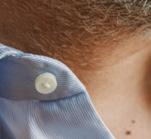
























“Independent minds look at watchmaking in a way that refuses to accept that everything has already been done. So the rattrapante function that we added to the crown and applied here is a true innovation”
THE TONDA GMT RATTRAPANTE HAS AN HOUR HAND INSTEAD OF A CHRONOGRAPH SECONDS HAND
to my arrival. It hasn’t been confirmed yet, but we might open one [additional] door next year in the Middle East,” notes Terreni.
An entry-level price point at Parmigiani is around SFr10,000. While a stainless-steel GMT Rattrapante costs around SFr26,000, a Tonda Split-Seconds Chronograph in platinum can retail for SFr155,000. Even at those price points, the demand for its timepieces is ever-present. Terreni confirms that plans are afoot to double production of its watches next year – provided that the suppliers and component manufacturers can keep up.
Parmigiani is a highly-integrated watch manufacture. The Sandoz Foundation which owns the company also owns other smaller companies such as Atokalpa, which specialises in hairsprings; Elwin, which makes screws; Les Artisans Boîtiers,



who are reputed casemakers, Quadrance & Habillage, experts in producing dials; and Vaucher Manufacture, a movement specialist (Hermès had previously acquired a 25 per cent stake in Vaucher). However, there are still components for which Parmigiani needs to turn to external suppliers. “The level of integration is extremely high in our manufacture, but it doesn’t mean that we are in control of the whole production process of a watch. We don’t do crowns, for example. We purchase subcomponents. You have more or less 100 suppliers to coordinate to make a watch. Even if you are an integrated watchmaker, you will still need to acquire a supply of specialised subcomponents. We don’t have a stock of components to ease the supply pressures. To produce a crown from scratch,
for example, took six weeks last year – today it takes 26 weeks.”

As Parmigiani ramps up production and arranges its supply chain to keep up with the demand, Terreni is interested in organically growing the appeal of the brand and not actively entering into collaborations. Before Terreni’s arrival, one of the most successful and long-running car and watch brand partnerships were struck between Parmigiani and Bugatti when in 2004 the two companies began collaborating on co-branded timepieces and continued to do so until 2019.

“I’m not interested in doing collaborations just to put the logos of brands on a Parmigiani watch. That’s a commercial activity, and we are not about being commercial. In the near future, I don’t see any collaboration coming up at Parmigiani,” states Terreni.
His independent state of mind is resolutely reflected in the attitude that the brand has adopted – not least of which was creating a GMT this year which altered the traditional definition of a GMT timepiece. “Today, independent brands are the frontier of luxury because they are challenging the status quo and are more creative. They also appeal more to collectors or people who don’t want to follow the crowd… and this is what true luxury is about.”
 BY NEESHA SALIAN
BY NEESHA SALIAN
Tell us about how L’Oréal performed in H1 2022.





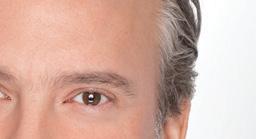



This year, L’Oréal witnessed an exceptional growth of over 13.5 per cent year-on-year in comparable sales and an over 20.9 per cent increase in reported sales in the first half of the year. We are proud to be contributing to this global performance, growing twice as fast as the local market in the region, with the active cosmetics division being a steady growth driver. For the last two years, we have gained an increase in market share in the region across all four of our divisions and categories.
What have been the key drivers of growth?
The market has rebounded fast and is close to its pre-pandemic growth pace. The beauty industry has enormous potential with new beauty and skincare needs, and young demographics that need to be served.


What are some of the key trends influencing the beauty industry globally and in the Middle East?
We believe beauty is an essential human need. Feeling beautiful endows people with confidence to achieve the things they
want to do in life. Consumers’ expectations towards beauty are constantly evolving, with the Covid-19 pandemic accelerating some of the pre-existing trends.
For example, women and men today look for personalised and inclusive


LAURENT DUFFIER, MANAGING DIRECTOR OF L’ORÉAL MIDDLE EAST, TALKS ABOUT TRANSFORMATIVE TRENDS, BEAUTY TECH, SUSTAINABILITY AND THE FUTURE OF BEAUTYLaurent Duffier
products, which are time e cient, backed up by science, respect the environment and are made from safe ingredients. They want brands that are not only here to sell products, but also have a purpose that resonates with their values.
They search for e cient brands that can sometimes be real life changers and at the same time totally safe. This has caused a spike in demand for dermo-cosmetics, sold in pharmacies, globally and in the region. Health-conscious beauty lovers are choosing products with vitamin C, hyaluronic acid and niacinamide, which boost skin moisture and improve quality of life.
As people return to their daily routines and work schedules, we are witnessing a comeback of makeup, as well, as a social category by essence. This category illustrates what we call the “lipstick e ect” and the fact that even in di cult economic times, buying lipstick is a small indulgence that almost all women can a ord.
We are also seeing increased shopping activity online in the region. Consumers are increasingly turning to direct-toconsumer e-commerce, such as a brand’s website, shoppable social media platforms or marketplaces because of its convenience and the wide variety of brands it o ers. We started our e-commerce journey a while ago and are fully prepared to take advantage of this trend.
Our customers also want personalised advice when choosing products, immersive and unique purchasing experiences, and direct access to their favourite brands. This is possible only through a well-established data-driven strategy and investments in artificial intelligence and other digital technologies that allow us to understand and even anticipate our customers’ needs to deliver the best service and products.
This year, we launched the first product powered by our ultra-personalisation service, Perso, in our L’Oréal Technology Incubator. The Yves Saint Laurent lipstick, Rouge Sur Mesure, takes the best of beauty tech and allows consumers to create their very own version of YSL’s iconic Velvet Cream Matte Finish lipstick in the comfort of their homes.
We have also implemented the Kérastase Hair Diagnostic Tool, where an advanced algorithm is used to analyse consumers’ scalp and hair needs, which is available in top salons across the GCC. These services are increasingly important to guide our

consumers in making the most informed decisions and provide them with experiences that are as personalised as possible.
In addition to the UAE, what are the key markets in the Middle East that will fuel growth over the next decade?
The GCC economies are expected to grow at their fastest pace in more than a decade, beating other emerging markets this year. With travel restrictions easing, tourism rebounding and strong domestic demand, there will be a positive upli t in all industries, including the beauty segment.
We believe that Saudi Arabia will be one of the prominent markets for cosmetics and fragrance products in the region in the coming years. The key drivers will be the economic growth of the country with investments tied to Vision 2030 initiatives, a growing young population, a middle class with more income linked to higher participation of Saudis, especially women, in the workforce, and the sophistication of the market enhanced by social media, which drives awareness of beauty products in the country.
Consumers in the kingdom tend to spend substantially on their personal appearance,



























and we expect this to continue, further boosting the dynamic growth of the cosmetic and fragrances market.
Finally, the penetration of organised retail channels o ine and online, with whom we are collaborating closely to provide the best possible beauty experiences to consumers, are also factors that will continue to accelerate the growth of the market.
A ter Expo 2020 Dubai, international events like the football World Cup, which will be held in our region this year, will certainly fuel demand in some categories, such as sun care. The most awaited event for e-commerce, White Friday, is also one of the biggest contributors to our growth for the second half of the year, with new launches, special o erings, and the maximisation of cross-selling opportunities across our categories.
How is the group leveraging its digital excellence to strengthen its e-commerce capabilities?
Digital and e-commerce are of strategic importance to our growth. E-commerce accounts for about 30 per cent of L’Oréal’s business around the world. Throughout the
“After Expo 2020 Dubai, international events like the football World Cup, which will be held in our region this year, will certainly fuel demand in some categories, such as sun care”
years, we have strengthened our digital and e-commerce capabilities to lead the growth of the market with our partners and on our brand sites. To be successful in e-commerce, you need strong hero products, great content on your platform and 360-degree marketing and advertising strategy in each category. We invest heavily in the upskilling of our teams and use a range of tools to measure the ROI of our actions.
We have been the first in the market to bring ‘live commerce’ events in 2022. This innovation allows customers to directly and seamlessly buy the products presented by influencers during an online show. Using the latest technologies available, we also continue to introduce new digital services to the region to assist consumers in choosing
products that match their preferences. For instance, during Ramadan, we created an AR-powered virtual mall in partnership with Snapchat that featured a beauty corner exclusive to Kérastase, YSL Beauty, Vichy and NYX, delivering a seamless shopping experience to consumers at home.
Moreover, in response to the common challenge that consumers in the region face with identifying the right skincare routine, we launched Skinconsult AI by Vichy, a skin analysis tool developed by dermatologists to detect, analyse and provide a customised skincare regimen, available right on your smartphone. We also launched – at YSL Beauty – the world’s first fragrance immersive technology supported by neuroscience to help consumers find
their fragrance of choice. By wearing a headset device and smelling different fundamental fragrance accords, the new EEG technology displays an emotional response to the scent, providing consumers with a bespoke and scientifically based product recommendation.

These beauty tech innovations will con tinue to play a huge role in the years to come.


Tell us about the company’s focus and investment in research and innovation. As the brainchild of scientist Eugene Schueller, L’Oréal was born – more than 100 years ago – on a foundation of science and innovation. Beauty never stands still. And neither do we. We invest EUR1bn each year into research and innovation to make sure we address our consumers’ needs. This makes us the largest investor in skin and hair research in the world.
We have 4,000 scientists working in 30 disciplines in 21 research and innovation centres around the world. In addition to that, we have 497 patents registered to date and are pioneers in ‘green sciences’, which we harness to meet our sustaina bility goals while offering consumers safe and effective products.
We also have a robust beauty tech strategy, aimed at revolutionising the way we respond to the diverse needs and aspirations of our consumers. We leverage artificial intelligence and data to create inclusive experiences and personalised products for them. Through our investment fund BOLD, we also collaborate and invest with startups to invent the new products and services of tomorrow.





At L’Oréal, our purpose is to “Create the Beauty that Moves the World”. Therefore, we have always been committed to protecting the beauty of the planet by fighting climate change, respecting biodiversity, and preserving natural resources. For example, we have already reduced the emissions of our industrial sites by 87 per cent compared to 2005 while, within the same period, increasing our production volumes by 37 per cent. This proves our ability to decouple growth from our impact on the environment.

95% OF OUR INGREDIENTS IN FORMULA WILL BE BIO-BASED, DERIVED FROM ABUNDANT MINERALS OR FROM CIRCULAR PROCESSES BY 2050
In 2020, we launched ‘L’Oréal for the Future’, the second phase of our sustainability programme, achievable by 2030. This is our pledge to use technology and green sciences to make better products – for us and our world – and minimise our carbon footprint.

L’Oréal for the Future 2030 targets were created to o set the impact of our operations on biodiversity, water, climate, and resource utilisation, as well as that of our 1.5 billion consumers. Through these science-based targets, we aim to achieve a total and radical reinvention of our global business and to limit our impact within which humanity can continue to develop and thrive for generations to come.
For instance, by 2025, all of L’Oréal’s sites will have achieved carbon neutrality by improving energy e ciency and using 100 per cent renewable energy.
In terms of our product o erings, 100 per cent of our plastic packaging will be refillable, reusable, recyclable or compostable by 2025, and 100 per cent of the plastics used in L’Oréal’s product packaging will be either from recycled or bio-based sources by 2030. Finally, 95 per cent of our ingredients in the formula will be bio-based, derived from abundant minerals or from circular processes by 2050. In line with our global framework, we have implemented
a ‘3Ws’ strategy in the region, focusing on women, water and waste.
Helping women has always been a natural focus for us and we are doing it in many ways. We are empowering them through our ‘Beauty for a Better Life’ training programme, delivering highquality, free vocational training to help them gain employment or create their own businesses in the beauty industry. We also encourage them to embrace scientific careers with our ‘L’Oréal-UNESCO For Women in Science’ programme that recognises exceptional scientists each year and grants them endowments to pursue their research.
To date, we have awarded 40 winners from the GCC in the past nine years. We also raise awareness of the street harassment plague and provide training on how to handle these situations with our ‘L’Oréal Paris Stand Up’ programme.
We had the biggest training on this theme at Expo 2020 Dubai last year.
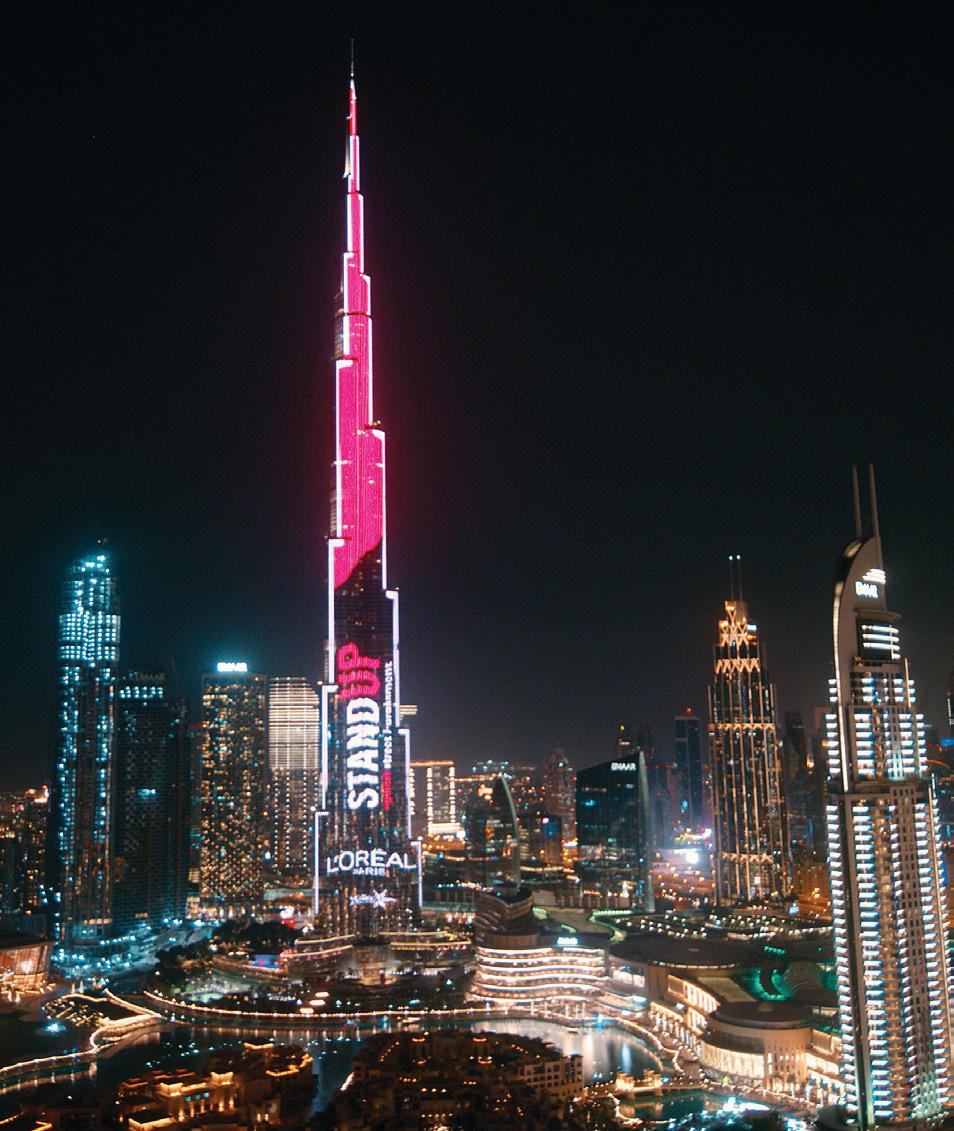
In terms of water, we work with salons to help them reduce their environmental impact by installing water-saving innovations, such as the Gjosa showerhead that can save up to 60 per cent water and encouraging them to use recycled and recyclable materials in the interiors of salons. We also provide our consumers with products that reduce water consumption such as solid shampoos.
As for waste, Garnier continues to contribute to a plastic-less future through its ‘Green Beauty’ commitments.
The brand partnered with Naqaa Sustainability Solutions and has already recycled 30 tonnes of plastic bottles in Saudi Arabia last year.
We live in a truly beautiful world, and believe it is our responsibility to do everything we can to ensure it stays beautiful.
WE WORK WITH SALONS TO HELP THEM REDUCE THEIR ENVIRONMENTAL IMPACT BY INSTALLING WATER-SAVING INNOVATIONS, SUCH AS THE GJOSA SHOWERHEAD THAT CAN SAVE UP TO 60 PER CENT WATER
Tell us about your journey with Ferrari. I’ve been with Ferrari for the last 10 years, and it has been a tremendous experience.
Initially, I worked at the company’s head quarters in Italy, as the marketing director for Europe, Middle East, and Africa. After moving to the region in 2015, I served as the sales director until 2018, following which I took on the role of general manager.
Tell us about the brand’s presence in the Middle East.
We’ve had a regional office here for 15 years. The Middle East is a very significant market for us, with the region’s luxury car market growing steadily year-on-year. In fact, we’ve seen accelerated growth after the pandemic. The region is a relatively young market for many brands, with lot

of expectations for the future, and Ferrari is among them.
What are the brand’s most popular models in the Middle East?
We have a wide and rich model range on offer, with models launched in the past couple of years that are just coming to the market now. For example, we’ve just
In true Prancing Horse tradition, Ferrari unveiled its first four-door, four-seater model. Ahead of its anticipated launch, Giorgio Turri, general manager of Ferrari Middle East, talked to Gulf Business about the Italian carmaker’s foray into this new space and the direction it heralds for the companystarted the deliveries of the SF90 Spider, 296 GTB and 812 Competizione. In 2023, we will start delivering the 296 GTS, Fer rari Purosangue and the new Daytona SP3.
The Purosangue marks a new era for Ferrari. Tell us about the strategy behind Ferrari’s deliberate transition to a four-door model for the first time in its 75-year-old history. Most certainly, the Ferrari Purosangue marks the start of a new segment — our target from the very beginning was to design and build something different. The
objective was to create a true sports car with an unprecedented level of comfort and versatility.
We did not start from an existing format, the so-called “SUV” platform, to produce and deliver the offered level of perfor mance on the car. That’s why we believe that Ferrari Purosangue is not an SUV, and is unlike any other vehicle in the market.
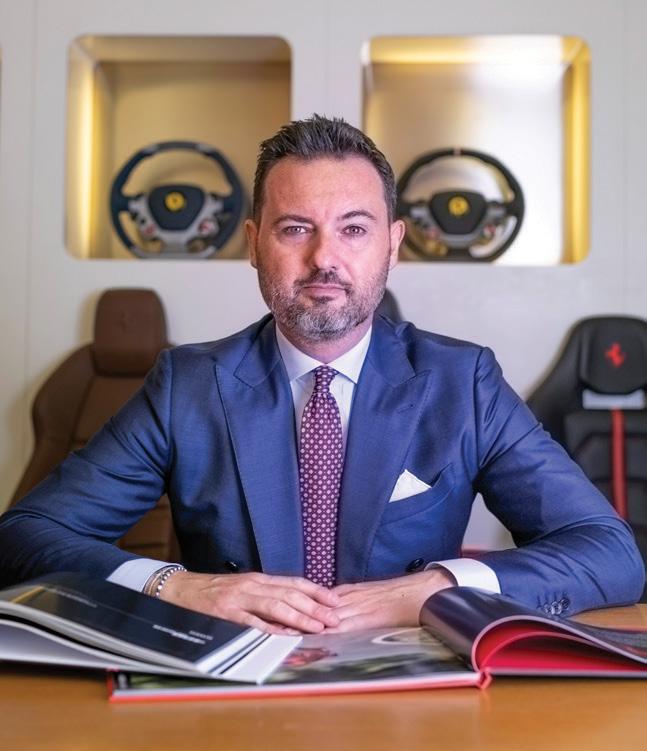
The four-door, four-seat format was a natural choice to enhance comfort and ver satility; they weren’t the starting point to design the project.
What I can say to answer your ques tion is that Ferrari will continue to remain loyal to the brand’s DNA and values. We will keep designing and producing sports cars offering superior driving emotions and performance, some of them with more versatility than others, in line with our objective to offer different Ferraris to dif ferent Ferraristi (Ferrari owners).
How do you see the Purosangue faring versus other models in your line-up?
At the Capital Markets’ Day in June, we publicly committed not to cross the 20 per cent threshold of sales during the lifecy cle of the model. The Purosangue is not a volume maker for us. The demand is over whelming and beyond expectation, but we are not going to be driven by one single model. We will keep it extremely exclusive while making sure that the volume allo cated is fitting with the market potential.
What can we expect from Ferrari next year? Our global strategy was unveiled at the Capital Markets Day, where we commit ted to launching 15 models between 2023 and 2026.

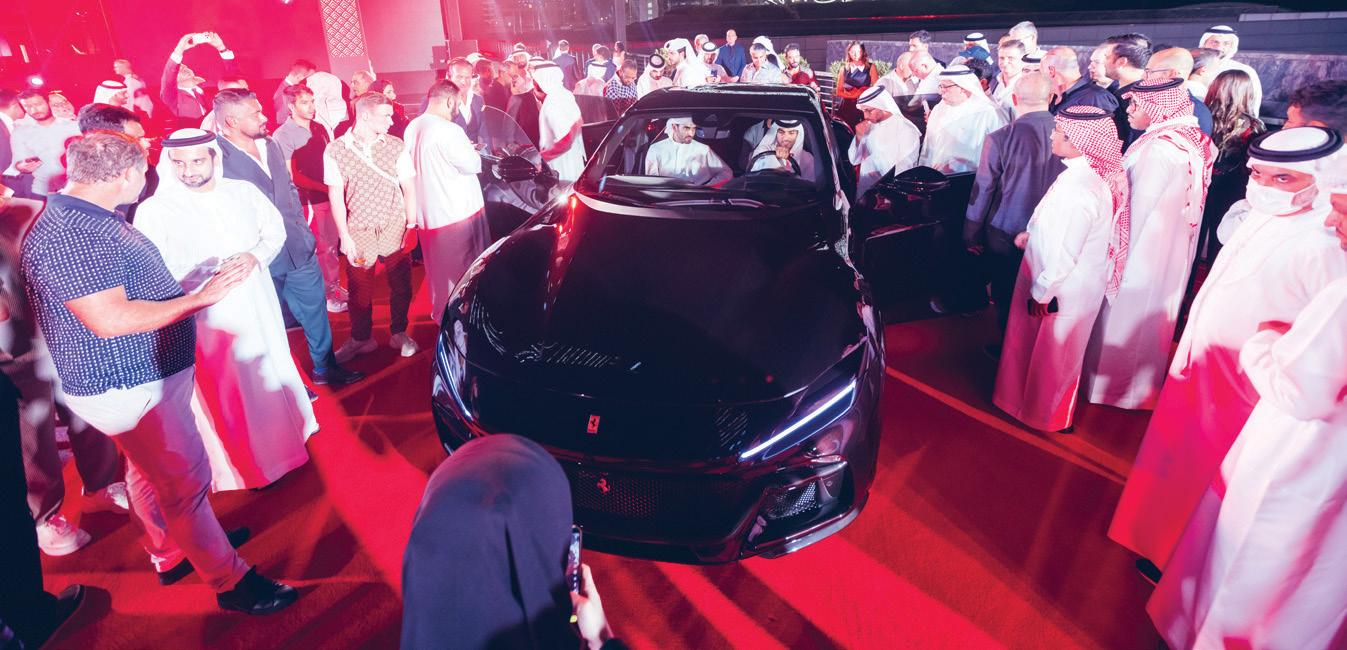
Next year, we will certainly present something new. For what concerns more specifically the Middle East, we will keep investing in enriching the customer expe rience and attracting new clients to the brand. In the past three years, more than 40 per cent of our cars have been delivered to new Ferraristi thanks to models such as the F8, Roma and 296.
We have also launched a new platform called ‘Club Challenge Middle East’ to offer our clients the chance to experience the race track with racing cars.
“The Ferrari Purosangue marks the start of a new segment — our target from the very beginning was to design and build something different. The objective was to create a true sports car with an unprecedented level of comfort and versatility”



A dedicated hub for the regional startup and SME ecosystem

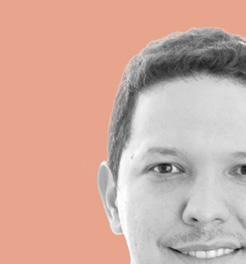
We shine the spotlight on innovative startups that are disrupting the world of hospitality, fragrances and vertical farming
whilst connecting directly with their customers.
Fast forward a couple of years, ChatFood’s offering has now been shaped into an omnichannel ordering and data-driven marketing platform integrated with exclusive social media integrations, over 100 POS partners, and premium logistic solutions (with an exclusive partnership with Careem).
ChatFood is an omnichannel ordering and data-driven marketing platform for leading hospitality brands. ChatFood’s mission is to empower hospitality businesses to give their guests a seamless, personalised and rewarding experience at every visit.
operators to give guests more control over their hospitality experience, unlock higher sales, reduce operating costs, and provide their employees with a more rewarding work experience. Hospitality groups are always on a drive to find new ways to keep growing their business and delighting their guests while keeping costs under control and employees engaged.
What are some of the challenges you faced when starting o ?


What inspired you to start this business?
Founded in early 2019, ChatFood was born to help hospitality businesses regain control of their relationship with customers, starting with their online business which has been monopolised by 3rdparty marketplaces. The company built an innovative mobile ordering solution to enable restaurants to sell from Instagram and WhatsApp (ChatFood has been awarded the WhatsApp partner badge)

Put simply, we believe that customers should have access to the most convenient way to order, regardless if they are first-time visitors or regulars. If they want to order food or drinks, they should be able to do so without having to struggle. They also shouldn’t have to wait 15 minutes to get their bill.


ChatFood’s tech-enabled service solutions such as QR ordering and payment, group tabs, digital tipping, or dynamic loyalty programmes, powered by the ChatFood dashboard, empower
The sentiment towards tech within the hospitality industry is quite segmented. We’re lucky enough to work with innovators that believe that tech will enhance the hospitality experience and want to invest in their brand to delight their customers. But there is also part of the market that is quite reluctant to change and a bit intimated by technology. They tend to wait and see how consumers’ demands evolve but they risk missing the train and losing their spot to the competition. The change is already happening and will be quick, those who miss it will struggle to survive in the longer term.
Give us a business overview of your operations and funding. ChatFood has already empowered over 3,000 hospitality venues across the

Middle East to drive more than $100m in sales and convert more than 1 million visitors into direct customers, growing at an impressive 260 per cent year-onyear. ChatFood’s newly launched NFC/ QR ordering system has been able to deliver outstanding results for its partners: 35 per cent higher average spend, 3x more tips, and 25 per cent more labour e ciency. This has allowed ChatFood to unlock revenue and margins at a

time of surging food costs, labour shortage, and increasing commissions for hospitality venues.
ChatFood recently raised a bridge round of $3m led by Antler. This brings ChatFood’s funding to date to $7m a ter last year’s seed round led by leading regional VC funds BECO and Wamda Capital. The funds will be primarily applied towards setting up operations in Saudi Arabia, where the market is expected to reach over $25bn by 2026, as well as product development with the aim to unlock further e ciencies for restaurants, bars, hotels and entertainment venues.
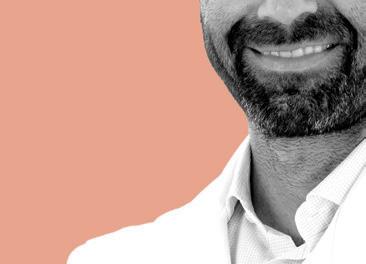
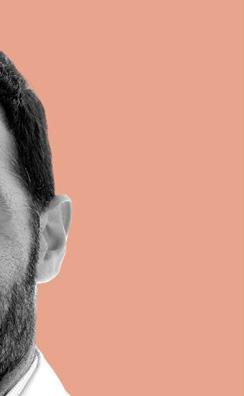

What are your growth plans?
ChatFood growth will be supported by geographic expansion and the growth of our dine-in o erings. From a geographic perspective, we plan to expand into the GCC market which is a $45bn market that is expected to double by


2025. In fact, the UAE and Saudi Arabia account for more than 70 per cent of the market. ChatFood is already a market leader in the UAE and will continue its growth across the Emirates. The funds recently raised will also be used to set up operations in Saudi Arabia to unlock e ciencies for restaurants, bars, hotels, and entertainment venues. Qatar is also a growing market where ChatFood is getting traction, especially as it will host the next football World Cup this month.
From an o ering perspective, we’re planning to close 2022 with $100m AGMV and $325m by the end of 2023, which will be mainly driven by dine-in adoption with more than 50 per cent of the GMV coming from order and payment at table solutions. We are also expanding our 360 platform with add-on services for our partners to better attract, engage and retain their customers such as our plug-and-play Careem delivery integration, our exclusive WhatsApp and Instagram features, and our marketing service packages.
In the next 10 to 20 years, the world will be faced with two major challenges that will threaten food security. With the world population set to reach 9.9 billion in 2050, according to global projections, the global consumption of meat and dairy will increase by up to 70 per cent. This will result in an unprecedentedly high demand in feeding people, as well as livestock. At the same time, the amount of arable land available to keep up with food production demand is decreasing significantly.
This problem inspired us to think about vertical farming innovatively, as it is key to solving these challenges globally. When looking at the entire supply chain of the industry, the production of animal fodder is one of the most important components to food security. If done sustainably, it can have a positive impact on the entire supply chain, while also making the food we consume more nutritious.
At World of Farming (WoF), we set out to tackle this in the most sustainable and innovative way – through a first-ofits-kind circular farming methodology
that will supply the local dairy and meat industry with highly nutritious, herbicides and pesticides free animal feed at a reduced cost, using up to 90 per cent less water and up to 90 per cent less land than traditional farming.
What are some of the challenges you faced when starting o ?
Similar to any other agritech startup across the region, we are seeing growing investor appetite for climate change, and driving more engagement on green investment opportunities, but there are still several challenges to overcome along the way. This includes creating greater awareness and mass market acceptance about adopting new and nonconventional grades of animal feed.
In order to continue ensuring opportunities for agritech take centrestage in the UAE and the wider region, governments, institutions, investors, and entrepreneurs all need to work together to generate a higher level of awareness and
Dr Walid Saad, co-founder and CEO, World of Farming
CHATFOOD HAS ALREADY EMPOWERED OVER 3,000 HOSPITALITY VENUES ACROSS THE MIDDLE EAST TO DRIVE MORE THAN $100 MILLION IN SALES
buy-in among farmers themselves, so that the fruits of Agritech can be at their fingertips.
What are some of the key milestones of your business?
Since launching earlier this year, we suc cessfully completed the first prototype of our patent-pending circular farming methodology, that uses our artificially intelligent tracking software technology, currently private BETA.
We were recently awarded our first customer contract to build, operate and manage a fully integrated circular farm in the UAE with a total output of 3,000 metric tonnes of fresh animal feed all year round.
What are some of the expansion plans you have in your pipeline?
WoF aims to build, operate, and manage farms across the region. Later this year we plan to secure more funding to further grow and scale our operations in the UAE and the wider MENA region, including Saudi Arabia.
We are simultaneously working with a number of local universities to empower youth and engage them in research and development programmes. We want to engage with these young innovators and give them the opportunity to develop local solutions that support the UAE’s national food security strategy.
The world is currently facing unprece dented food security challenges, ineffi cient supply chains, as well as geopolitical tensions. This does not help regions like the GCC, which are known to have a harsh environment for farming due to high temperatures, scarcity of arable land, and limited freshwater resources. As a result, the UAE, for example, imports
80-90 per cent of the food it consumes, including livestock feed.
Instead of producing an output directly for human consumption, our approach serves to tackle a major problem which begins at the very top: to sustainably feed livestock with on-site production of fresh fodder. In line with the UAE’s National Food Strategy 2051, WoF’s vertical farming model will enable local farmers to produce fresh, and cost-effective, local alternatives to international imports of animal fodder independently, efficiently, and
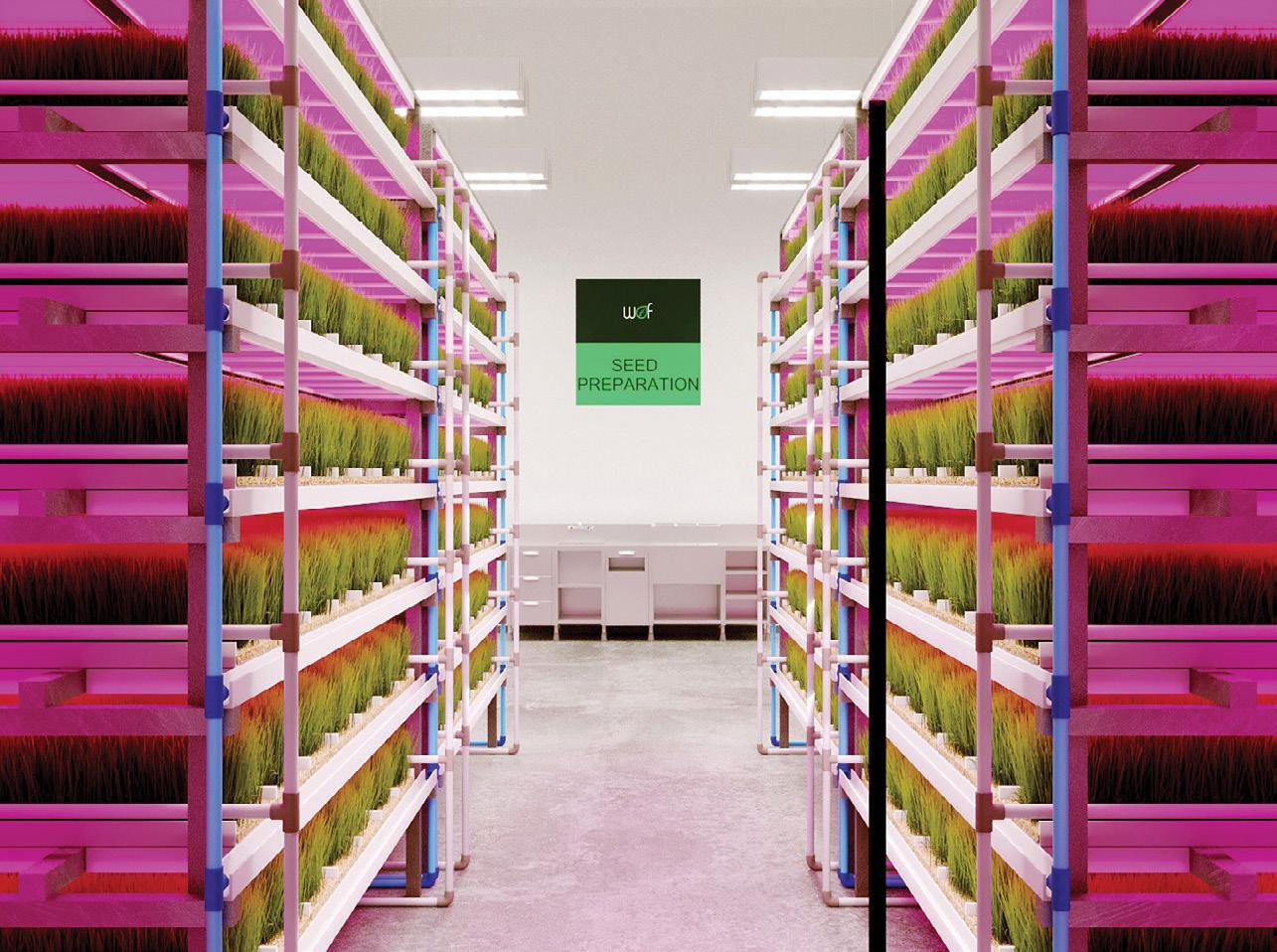
more sustainably. When done at scale, it will have an immense impact on regional food security, as well as in cutting greenhouse gas emissions from conventional animal feed production and transportation globally.
Our process involves a full circular farming methodology which we named ‘The Cattleyst’, to sustainably produce our livestock fodder.
The patent-pending methodology is a closed loop system that reduces methane emissions to the atmosphere by recycling cattle manure, while ensuring farm output is being used as input in the farming operation.
This approach will supply the local dairy and meat industry with highly nutritious, herbicides and pesticides free animal feed at reduced cost, using up to 90 per cent less water and up to 90 per cent less land than traditional farming.
“OUR PROCESS INVOLVES A FULL CIRCULAR FARMING METHODOLOGY WHICH WE NAMED ‘THE CATTLEYST’, TO SUSTAINABLY PRODUCE OUR LIVESTOCK FODDER. THE PATENTPENDING METHODOLOGY IS A CLOSED LOOP SYSTEM THAT REDUCES METHANE EMISSIONS TO THE ATMOSPHERE BY RECYCLING CATTLE MANURE, WHILE ENSURING FARM OUTPUT IS BEING USED AS INPUT IN THE FARMING OPERATION”
ACCORDING TO GLOBAL PROJECTIONS, THE GLOBAL CONSUMPTION OF MEAT AND DAIRY WILL INCREASE BY UP TO 70 PER CENT
What is the core concept of Airzai? How is it bringing a change in the home fragrance industry?


Airzai, a tech-fragrance company, is leading the charge in creating ‘the future of fragrance and wellness’ by leveraging technology, specifically artifical intelligence (AI) and machine learning to build what they call “the smartest fragrance di user in the world”.
The core concept is very simple. Airzai aims to be the smartest fragrance di user in the world. What that means is that the founders are using their prior extensive experience in tech and AI to bring true disruption in the age-old fragrance industry.
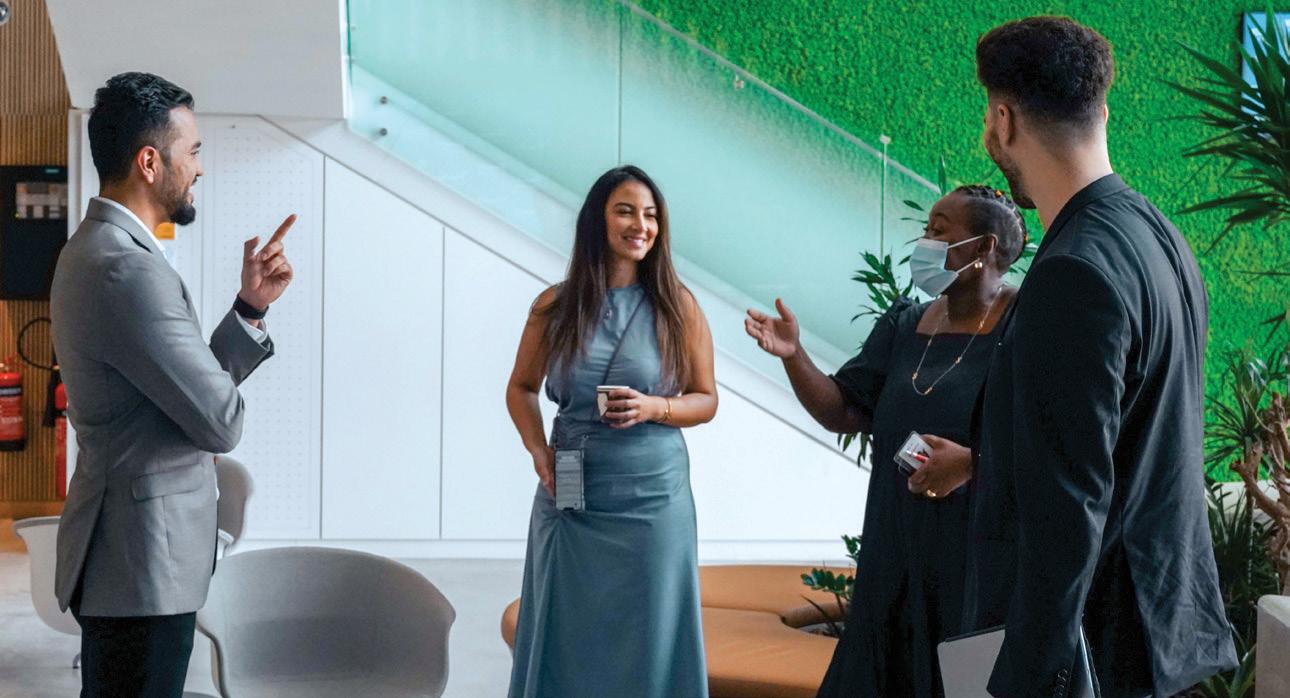
Many consumers don’t realise that candles are extremely toxic and in general dangerous to our health, especially kids and pets. Moreover, they can be costly as you are literally burning the money. The other solutions in the market
“THE INDUSTRY IS GROWING AT A CAGR OF 7.3 PER CENT WITH THE TOTAL ADDRESSABLE MARKET (TAM) OF OVER $10BN BY 2028 GLOBALLY. THE BIGGEST CATALYST TO CONTRIBUTE TO THIS BOOST IS THE PANDEMIC. AS MORE AND MORE PEOPLE WORKED FROM HOME AND PERSONAL SPACES, THEY REALISED THE IMPORTANCE OF FRAGRANCES”
such as no-name brand di users contain synthetic and sometimes toxic ingredients in their oils.
Airzai aims to target all these pain points and deliver on a fragrance experience that is premium, natural, trustworthy and leveraging technology to enhance the fragrance experience.
The flagship product, Airzai Aroma, is a patent-pending innovative smarthome di user that upli ts the mood and transforms the home into smelling like a luxury resort.
What are some of the challenges you faced when starting o ?
One of the biggest challenges was to find the right hardware partners, both on industrial design and then the technical side. A ter losing personal funds on making wrong hires, we came across

Fred Bould, who is regarded as one the most experienced and celebrated industrial designers of our time. It was an even bigger challenge getting him onboard, but our persistance paid o , with Fred Bould joining us as the chief designer of Airzai.
Give us an overview of your funding, operations and your plans to utilise it. So far Airzai had raised over $1.5m in funding. We recently closed on another $2.5m recently and are now raising $5m to launch the product. The expected date for close is Q3 2022. Originally the funds were used for R&D, protecting IP and AI. Now the focus is on manufacturing, marketing and PR.
What are some of the growth and expansion plans you have in your pipeline?
We can’t share much just yet but the plan is to originally sell the product through online channels beginning with the US market but we have recently seen quite a lot of interest in the UAE market so this could potentially be one of our launch markets. We opened our limited preorder campaign mid-July and got sold out in less than four hours. There seems to be a lot of excitement around Airzai aroma, which we are very excited about.
What are your predictions for how the perfume and fragrance market will evolve going forward in the region?
The industry is growing at a CAGR of 7.3 per cent with the total addressable market (TAM) of over $10bn by 2028 globally. The biggest catalyst to contribute to this boost is the pandemic. As more and more people worked from home and personal spaces, they realised the importance of fragrances. Our olfactory system is one of the most active and sensitive senses that we o ten ignore.
Aside from making the environment pleasant, scents and essential oils are known to drive health and mental wellness benefi ts as well. And with depression, anxiety and other similar conditions rising at alarming rates, consumers are keen to bring unique solutions including fragrances into their lifestyle in order to drive wellness.
Muneeb Mushtaq, co-founder, Airzai

Smalland medium enterprises (SMEs) are viewed as the foundation of every economy. The scale of the small and medium enterprises and the number of individuals engaged in this sector demonstrate their critical significance in the growth of an economy.
This significance is also acknowledged by policymakers, who are working to create a business-friendly climate for SMEs to boost their financial development and growth.
Even though the significance and con tribution of SMEs to the economy are widely acknowledged, there are many small businesses and startups that face a myriad of challenges. Among the most sig nificant impediments is a lack of financial resources to sustain its competitiveness and grow the business.
If the SME sector is unable to secure the necessary cash to operate optimally, it will be unable to fund its investment and
day-to-day operations. As a result, the expansion of SMEs is largely constrained.
Technological advancements have created a possibility for the growth of a new industry, financial technology. Using the advancements in technology, this industry provides a much-needed service. New alternative finance channels have emerged with the goal of servicing the economy’s underserved segments.

The SME sector has understood the importance of alternative financing. Because of the digitisation of their operations, fintech businesses may provide easily-accessible, lower-cost loans, significantly lower-cost transactions, speedier application processes, and so on.
The biggest limitation for SMEs in regards to their expansion and scaling is the fact that most of them don’t have access to capital. Due to inadequate collateral, smaller asset size, and a limited previous
track record, commercial banks often regard SMEs to be high default risk –an unfortunate factor that has, in turn, hampered the growth of SMEs globally and especially in developing markets.
To enhance institutional credit flow to SMEs, legislatures in various countries have implemented a variety of measures including subsidised interest rates, collateral-free loans, partial credit guarantees, credit insurance, matching grants, and so on. Many nations have also established separate stock markets for SMEs further simplifying the muchneeded access to capital market resources. However, the institutional credit route remains inefficient, preventing many SMEs from expanding their operations.
Why alternative financing could address the financial needs of UAE-based SMEs
An alternative path
Many measures taken by the government during the pandemic – such as tax deferrals and state loans – have helped SMEs survive (some maintaining to trade at lower levels, others furloughed), but cash flow issues will persist as enterprises strive to return to ‘normal’ trading volumes.
Alternative funding is accessible through the fintech industry and can provide a life line for enterprises in desperate need –and businesses must enlighten themselves about the possibilities available.
Alternative finance is a developing channel in financial intermediation and is technology-driven. Crowdfunding and peer-to-peer (P2P) lending are two exam ples of the same. Crowdfunding is a digital platform that has three moving parts — the SME business seeking financing, the donors willing to support the project, and the regu lating organisation that promotes interac tion between the donors and the originator.
The moderating organisation provides participants with information on various programmes and financing possibilities for product/service development. Organisations and owners alike can lend and borrow from each other via the P2P platform. Thanks to their foothold in IT Design, P2P platforms often offer cheap interest rates and an enhanced lending procedure to both lenders and borrowers.
Furthermore, because they have automated onboarding, ID verification, and immediate bank account openings, fintech companies like these have been able to disburse cash with government programmes faster than banks. However, these initiatives are coming to an end, and SMEs will soon need to seek capital from nongovernment sources.
These options have assisted thousands of enterprises not just in staying afloat during the pandemic, but also in getting access to the finances required for the production of goods, hiring new talent, and penetrating new markets. The goal is to empower owners to embrace a new era of corporate financing.
Usually, small businesses benefit when seeking finance from an unconventional source. These alternatives help the owner collaborate with a powerful, invested partner who may expose businesses to qualified leads, analysts, the media, and other partnerships.
Some advantages of partnering with an atypical lender include:
The business may loan some of the strategic partner’s goodwill, and cooperating with an experienced investor adds weight to the brand.
The bigger partner is likely to have groups for marketing, IT, finance, and human resources – all of which a startup may use at a discounted rate.

As part of this deal, the strategic partner is likely to join your board. Understand that they will have a plethora of business expertise, so their opinion and perspectives will be useful.
A strategic partner that might not be
involved in the day-to-day operations of the startup. Scheduled updates about your business are generally adequate check-ins for them.
Businesses can access the world’s most cost-effective markets where the factoring solution provider has a presence. Factoring also allows for longer payment terms giving businesses a better chance to compete effectively in the marketplace.
In a nutshell, factoring is largely a type of financing that is based on the creditworthiness of a company’s buyers, rather than on the financials of their own business. Also, since it’s not a loan, it will not appear on the balance sheet as debt. It also allows businesses to closely monitor the creditworthiness of their customers and covers the risk of shortfall of payment in the case these customers become insolvent. Lastly, it allows businesses to offer longer payment terms and, therefore, attract larger buyers.
When circumstances are tough, it isn’t just about bringing money in, but also about keeping money in; SMEs must consider cash flow preservation. P2P lending and crowdsourcing help businesses with shortterm financial loans.
To promote alternative funding sources for SMEs, regulations that support a variety of financial mechanisms for SMEs while preserving monetary sustainability and investor protection, as well as tax incentives to stimulate investment in SMEs, are the need of the hour.
While there have been ongoing discussions about the emergence of alternative financing in recent years, knowledge among company owners remains low. We must alter this after the epidemic, not just for the sake of these businesses, but also for the sake of our economy.
“USUALLY, SMALL BUSINESSES BENEFIT WHEN SEEKING FINANCE FROM AN UNCONVENTIONAL SOURCE. THESE ALTERNATIVES HELP THE OWNER COLLABORATE WITH A POWERFUL, INVESTED PARTNER WHO MAY EXPOSE BUSINESSES TO QUALIFIED LEADS, ANALYSTS, THE MEDIA, AND OTHER PARTNERSHIPS”
EFG Hermes Holding, a universal bank in Egypt with a market-leading investment bank franchise in Frontier Emerging Markets (FEM), offers a diversi ed suite of services and products, tailored to meet clients' nancing and investment needs. The Firm's services range from securities brokerage, advisory, asset management, private equity and award-winning research, to non-bank nancial solutions such as leasing, factoring, micro nance, buy-now pay-later (BNPL) ntech services, insurance and mortgage nance, as well as commercial banking.






